Paul van Yperen's Blog, page 208
January 27, 2020
Midinettes (1917)
Star of the French silent film Midinettes (René Hervil, Louis Mercanton, 1917) is striking, sophisticated Suzanne Grandais. She was the most beautiful and refined actress of the French silent cinema. Her nickname was 'the French Mary Pickford' because of her angel face and blond hair. She died in a car crash when she was only 27.
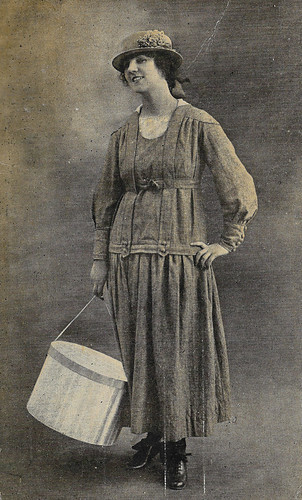
Spanish collectors card by Amatller Marca Luna chocolate, series 3, no. 1. Photo: Eclipse. Suzanne Grandais in Midinettes (René Hervil, Louis Mercanton, 1917).
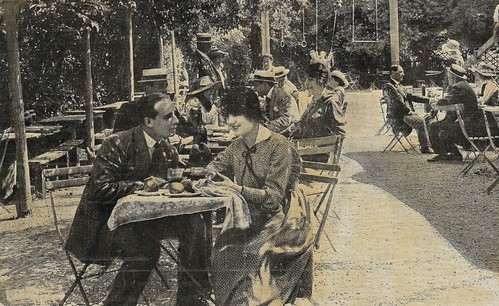
Spanish collectors card by Amatller Marca Luna chocolate, series 3, no. 2. Photo: Eclipse. Suzanne Grandais and Brodsky in Midinettes (René Hervil, Louis Mercanton, 1917).
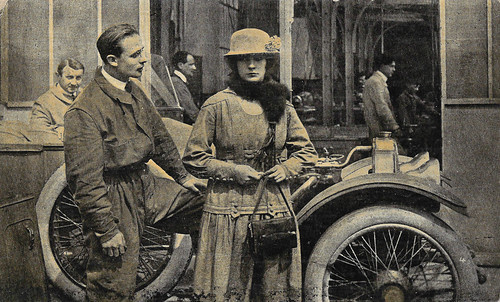
Spanish collectors card by Amatller Marca Luna chocolate, series 3, no. 3. Photo: Eclipse. Brodsky and Suzanne Grandais in Midinettes (René Hervil, Louis Mercanton, 1917).
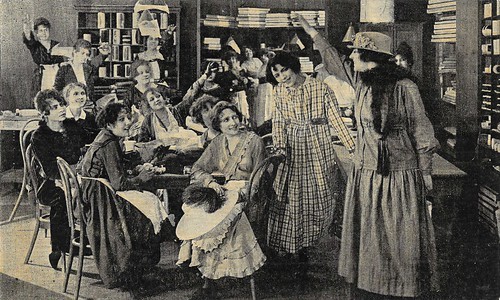
Spanish collectors card by Amatller Marca Luna chocolate, series 3, no. 4. Photo: Eclipse. Suzanne Grandais in Midinettes (René Hervil, Louis Mercanton, 1917).
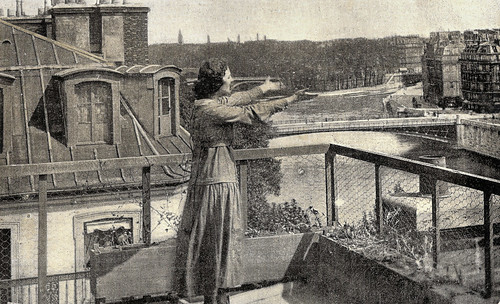
Spanish collectors card by Amatller Marca Luna chocolate, series 3, no. 5. Photo: Eclipse. Suzanne Grandais in Midinettes (René Hervil, Louis Mercanton, 1917).
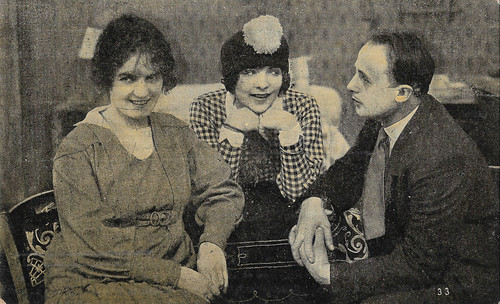
Spanish collectors card by Amatller Marca Luna chocolate, series 3, no. 6. Photo: Eclipse. Suzanne Grandais , Jane Danjou and Brodsky in Midinettes (René Hervil, Louis Mercanton, 1917).
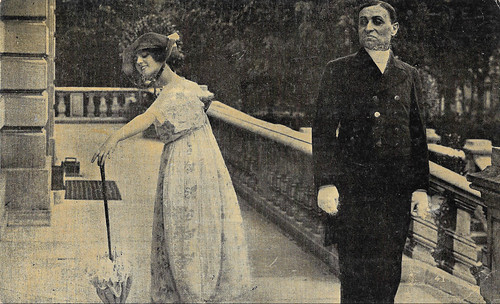
Spanish collectors card by Amatller Marca Luna chocolate, series 3, no. 7. Photo: Eclipse. Suzanne Grandais in Midinettes (René Hervil, Louis Mercanton, 1917).
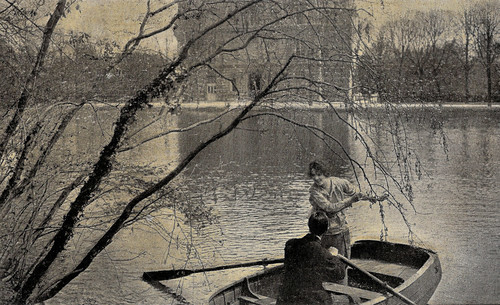
Spanish collectors card by Amatller Marca Luna chocolate, series 3, no. 8. Photo: Eclipse. Suzanne Grandais and Jean Peyrière in Midinettes (René Hervil, Louis Mercanton, 1917).
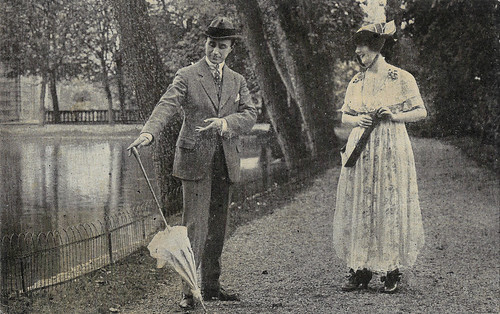
Spanish collectors card by Amatller Marca Luna chocolate, series 3, no. 9. Photo: Eclipse. Jean Peyrière and Suzanne Grandais in Midinettes (René Hervil, Louis Mercanton, 1917).
Her light love for a young mechanic
Midinettes (René Hervil, Louis Mercanton, 1917) aka Midinette was one of the typical films of the so-called 'Third Series' of Suzanne Grandais films, produced by Charles Mary for the film company Eclipse. The Spanish postcards which we use for this post, were published by the chocolate company Amatller Marca Luna. Amatller published several series on the films with Grandais.
Ciné-Journal described the content as follows: "Midinette is the simple adventure of a charming little seamstress, that belongs to a big fashion house, in which she leads the usual life of female workers, a life shared between the workshop, her little room, and her light love for a young mechanic.
Then suddenly a radical shift takes place in her life when she gets a large heritance. She turns into a wealthy lady and is courted by a debt-ridden aristocrat, who would like to recolour his blazon with Rosette's blue billets. The delicious young girl brings all of her independence and her neighbourhood esprit into the milieu. But after some time, the exquisite Rosette understands she has no real vocation for the aristocracy, so she returns to her room and her mechanic, whom she marries."
The 'midinettes' (seamstresses) were called this way, because they often lived far from their work, and at lunchtime they had to eat quickly. So they had a 'dinette' at 'midi'.
Suzanne Grandais played Rosette of course, while Jean Peyrière played the young Duke, Anthony Gildès and Marie-Ange Fériel played his parents, and Jane Danjou played Rosette's friend. It is unclear who played the mechanic; it probably was (first name unknown) Brodsky. Directors René Hervil and Louis Mercanton were also the co-writers of the film, while the regular cinematographer of Eclipse, Wladimir, took care of the photography.
Midinettes (René Hervil, Louis Mercanton, 1917) premiered in Paris on 10 August 1917. While the plot was quite simple, the press lauded Grandais' performance as well as that of her co-star Danjou. The critics also liked the several shots shot on location in Paris, such as that of the walk by the lake at night.
The film came out in a particular context, because in May 1917 the real 'midinettes' raised a strike in France, refusing a reduction of their salary because of the war. Already because of the war, they were forced to work 10 hours a day. Just like in Britain, the French employers cut half a day of work on Saturday, but in contrast to the Brits, they would not pay for it. Soon, all Parisian female seamstresses were on strike. Moreover, the strike quickly spread also to female workers working in factories and banks, so within 5 days some 10.000 women were on strike.
In the end, French employers gave in and accepted the 'English week' of one and a half-day paid weekend. This was the first step in the recognition of a weekend. Up till then, few women had joined a union because of their work being mostly domestic, but because of the strike, by the end of 1917, a third of the members of the big CGT union consisted of women.
Yet, Laure Lee Downs, in her book 'Manufacturing Inequality: Gender Division in the French and British Metalworking Industries, 1914-1939' (1995), writes that the midinettes, with their flowers on their clothes and waving the national flags, were easier embraced by the bourgeois establishment than the 'munitionettes' (the women working in the weapon factories), waving red flags and behaving less gentle. The latter group would 'face arrest, interrogation, imprisonment, and victimization of those identified as ringleaders."
One may wonder what the real midinettes may have thought of the deterministic, conventional storyline of Midinettes - stay within your class. On the other hand, during a war, the government probably would not have allowed for a film that came too close to reality.
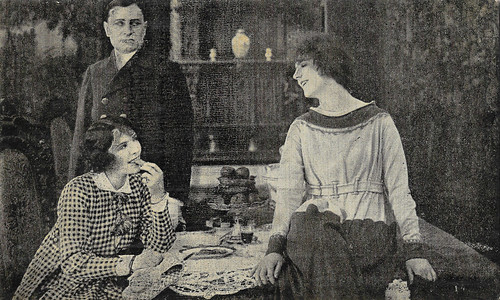
Spanish collectors card by Amatller Marca Luna chocolate, series 3, no. 10. Photo: Eclipse. Jane Danjou, Brodsky and Suzanne Grandais in Midinettes (René Hervil, Louis Mercanton, 1917).
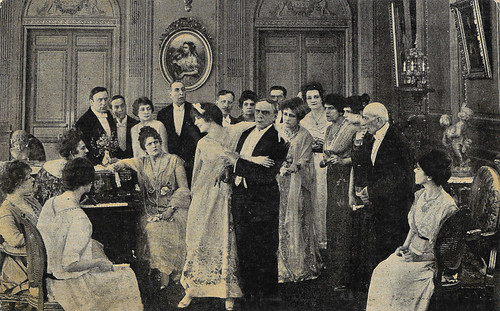
Spanish collectors card by Amatller Marca Luna chocolate, series 3, no. 11. Photo: Eclipse. Suzanne Grandais and Anthony Gildès in Midinettes (René Hervil, Louis Mercanton, 1917).
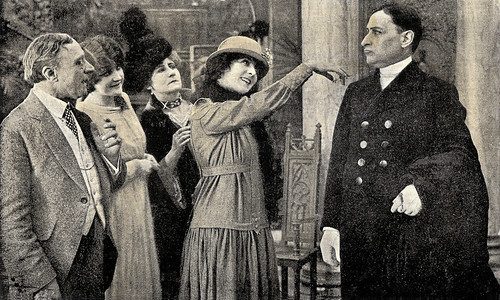
Spanish collectors card by Amatller Marca Luna chocolate, series 3, no. 12. Photo: Eclipse. Suzanne Grandais and Marcel Marquet in Midinettes (René Hervil, Louis Mercanton, 1917).
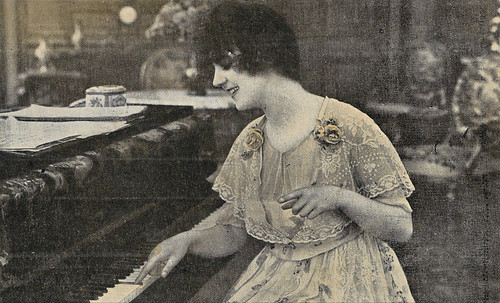
Spanish collectors card by Amatller Marca Luna chocolate, series 3, no. 13. Photo: Eclipse. Suzanne Grandais in Midinettes (René Hervil, Louis Mercanton, 1917).
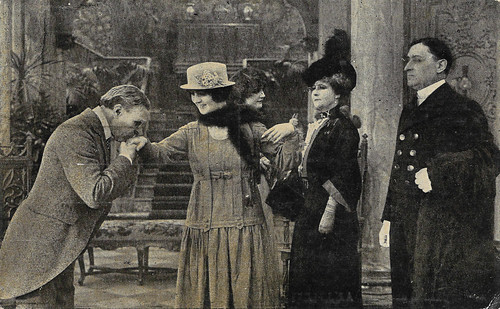
Spanish collectors card by Amatller Marca Luna chocolate, series 3, no. 14. Photo: Eclipse. Anthony Gildès, Suzanne Grandais , Marie-Ange Fériel and Marcel Marquet in Midinettes (René Hervil, Louis Mercanton, 1917).
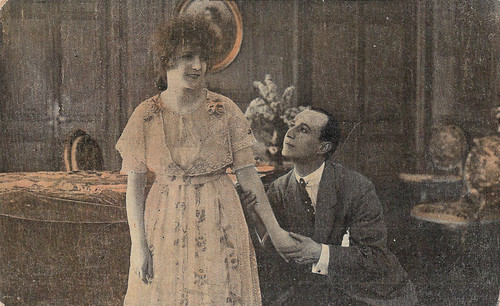
Spanish collectors card by Amatller Marca Luna chocolate, series 3, no. 15. Photo: Eclipse. Suzanne Grandais and Jean Peyrière in Midinettes (René Hervil, Louis Mercanton, 1917).
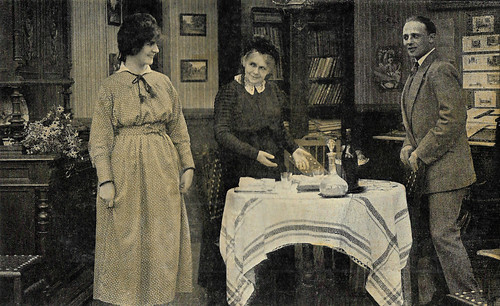
Spanish collectors card by Amatller Marca Luna chocolate, series 3, no. 16. Photo: Eclipse. Suzanne Grandais , Berthe Jalabert and Brodsky in Midinettes (René Hervil, Louis Mercanton, 1917).
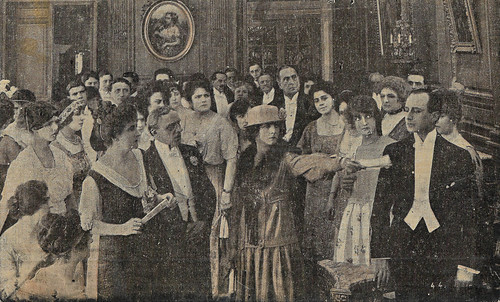
Spanish collectors card by Amatller Marca Luna chocolate, series 3, no. 17. Photo: Eclipse. Marie-Ange Fériel, Anthony Gildès, Suzanne Grandais and Jean Peyrière in Midinettes (René Hervil, Louis Mercanton, 1917).
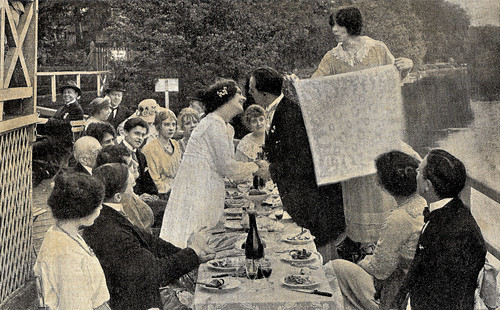
Spanish collectors card by Amatller Marca Luna chocolate, series 3, no. 18. Photo: Eclipse. Suzanne Grandais , Brodsky and Jane Danjou in Midinettes (René Hervil, Louis Mercanton, 1917). This card shows the conclusion of the plot.
Sources: Gauchemip (French) Ciné-Journal (14 July 1917- French), Wikipedia and IMDb.

Spanish collectors card by Amatller Marca Luna chocolate, series 3, no. 1. Photo: Eclipse. Suzanne Grandais in Midinettes (René Hervil, Louis Mercanton, 1917).

Spanish collectors card by Amatller Marca Luna chocolate, series 3, no. 2. Photo: Eclipse. Suzanne Grandais and Brodsky in Midinettes (René Hervil, Louis Mercanton, 1917).

Spanish collectors card by Amatller Marca Luna chocolate, series 3, no. 3. Photo: Eclipse. Brodsky and Suzanne Grandais in Midinettes (René Hervil, Louis Mercanton, 1917).

Spanish collectors card by Amatller Marca Luna chocolate, series 3, no. 4. Photo: Eclipse. Suzanne Grandais in Midinettes (René Hervil, Louis Mercanton, 1917).

Spanish collectors card by Amatller Marca Luna chocolate, series 3, no. 5. Photo: Eclipse. Suzanne Grandais in Midinettes (René Hervil, Louis Mercanton, 1917).

Spanish collectors card by Amatller Marca Luna chocolate, series 3, no. 6. Photo: Eclipse. Suzanne Grandais , Jane Danjou and Brodsky in Midinettes (René Hervil, Louis Mercanton, 1917).

Spanish collectors card by Amatller Marca Luna chocolate, series 3, no. 7. Photo: Eclipse. Suzanne Grandais in Midinettes (René Hervil, Louis Mercanton, 1917).

Spanish collectors card by Amatller Marca Luna chocolate, series 3, no. 8. Photo: Eclipse. Suzanne Grandais and Jean Peyrière in Midinettes (René Hervil, Louis Mercanton, 1917).

Spanish collectors card by Amatller Marca Luna chocolate, series 3, no. 9. Photo: Eclipse. Jean Peyrière and Suzanne Grandais in Midinettes (René Hervil, Louis Mercanton, 1917).
Her light love for a young mechanic
Midinettes (René Hervil, Louis Mercanton, 1917) aka Midinette was one of the typical films of the so-called 'Third Series' of Suzanne Grandais films, produced by Charles Mary for the film company Eclipse. The Spanish postcards which we use for this post, were published by the chocolate company Amatller Marca Luna. Amatller published several series on the films with Grandais.
Ciné-Journal described the content as follows: "Midinette is the simple adventure of a charming little seamstress, that belongs to a big fashion house, in which she leads the usual life of female workers, a life shared between the workshop, her little room, and her light love for a young mechanic.
Then suddenly a radical shift takes place in her life when she gets a large heritance. She turns into a wealthy lady and is courted by a debt-ridden aristocrat, who would like to recolour his blazon with Rosette's blue billets. The delicious young girl brings all of her independence and her neighbourhood esprit into the milieu. But after some time, the exquisite Rosette understands she has no real vocation for the aristocracy, so she returns to her room and her mechanic, whom she marries."
The 'midinettes' (seamstresses) were called this way, because they often lived far from their work, and at lunchtime they had to eat quickly. So they had a 'dinette' at 'midi'.
Suzanne Grandais played Rosette of course, while Jean Peyrière played the young Duke, Anthony Gildès and Marie-Ange Fériel played his parents, and Jane Danjou played Rosette's friend. It is unclear who played the mechanic; it probably was (first name unknown) Brodsky. Directors René Hervil and Louis Mercanton were also the co-writers of the film, while the regular cinematographer of Eclipse, Wladimir, took care of the photography.
Midinettes (René Hervil, Louis Mercanton, 1917) premiered in Paris on 10 August 1917. While the plot was quite simple, the press lauded Grandais' performance as well as that of her co-star Danjou. The critics also liked the several shots shot on location in Paris, such as that of the walk by the lake at night.
The film came out in a particular context, because in May 1917 the real 'midinettes' raised a strike in France, refusing a reduction of their salary because of the war. Already because of the war, they were forced to work 10 hours a day. Just like in Britain, the French employers cut half a day of work on Saturday, but in contrast to the Brits, they would not pay for it. Soon, all Parisian female seamstresses were on strike. Moreover, the strike quickly spread also to female workers working in factories and banks, so within 5 days some 10.000 women were on strike.
In the end, French employers gave in and accepted the 'English week' of one and a half-day paid weekend. This was the first step in the recognition of a weekend. Up till then, few women had joined a union because of their work being mostly domestic, but because of the strike, by the end of 1917, a third of the members of the big CGT union consisted of women.
Yet, Laure Lee Downs, in her book 'Manufacturing Inequality: Gender Division in the French and British Metalworking Industries, 1914-1939' (1995), writes that the midinettes, with their flowers on their clothes and waving the national flags, were easier embraced by the bourgeois establishment than the 'munitionettes' (the women working in the weapon factories), waving red flags and behaving less gentle. The latter group would 'face arrest, interrogation, imprisonment, and victimization of those identified as ringleaders."
One may wonder what the real midinettes may have thought of the deterministic, conventional storyline of Midinettes - stay within your class. On the other hand, during a war, the government probably would not have allowed for a film that came too close to reality.

Spanish collectors card by Amatller Marca Luna chocolate, series 3, no. 10. Photo: Eclipse. Jane Danjou, Brodsky and Suzanne Grandais in Midinettes (René Hervil, Louis Mercanton, 1917).

Spanish collectors card by Amatller Marca Luna chocolate, series 3, no. 11. Photo: Eclipse. Suzanne Grandais and Anthony Gildès in Midinettes (René Hervil, Louis Mercanton, 1917).

Spanish collectors card by Amatller Marca Luna chocolate, series 3, no. 12. Photo: Eclipse. Suzanne Grandais and Marcel Marquet in Midinettes (René Hervil, Louis Mercanton, 1917).

Spanish collectors card by Amatller Marca Luna chocolate, series 3, no. 13. Photo: Eclipse. Suzanne Grandais in Midinettes (René Hervil, Louis Mercanton, 1917).

Spanish collectors card by Amatller Marca Luna chocolate, series 3, no. 14. Photo: Eclipse. Anthony Gildès, Suzanne Grandais , Marie-Ange Fériel and Marcel Marquet in Midinettes (René Hervil, Louis Mercanton, 1917).

Spanish collectors card by Amatller Marca Luna chocolate, series 3, no. 15. Photo: Eclipse. Suzanne Grandais and Jean Peyrière in Midinettes (René Hervil, Louis Mercanton, 1917).

Spanish collectors card by Amatller Marca Luna chocolate, series 3, no. 16. Photo: Eclipse. Suzanne Grandais , Berthe Jalabert and Brodsky in Midinettes (René Hervil, Louis Mercanton, 1917).

Spanish collectors card by Amatller Marca Luna chocolate, series 3, no. 17. Photo: Eclipse. Marie-Ange Fériel, Anthony Gildès, Suzanne Grandais and Jean Peyrière in Midinettes (René Hervil, Louis Mercanton, 1917).

Spanish collectors card by Amatller Marca Luna chocolate, series 3, no. 18. Photo: Eclipse. Suzanne Grandais , Brodsky and Jane Danjou in Midinettes (René Hervil, Louis Mercanton, 1917). This card shows the conclusion of the plot.
Sources: Gauchemip (French) Ciné-Journal (14 July 1917- French), Wikipedia and IMDb.
Published on January 27, 2020 22:00
January 26, 2020
Hesperia
Hesperia (1885-1959), was one of the Italian divas of the silent screen. In her films, she could get into uncontrollable rages but also into wildly merry moods. Hesperia often worked with director Baldassarre Negroni, who later became her husband. In later life, the formerly 'dishonoured woman' whose family had once closed the door to her because of her vaudeville career, became a countess.
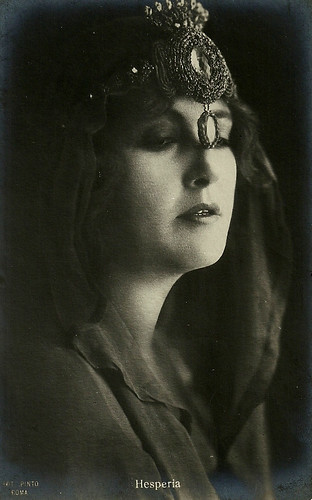
Italian postcard by Ed. A. Traldi, Roma. Photo: Pinto, Roma.
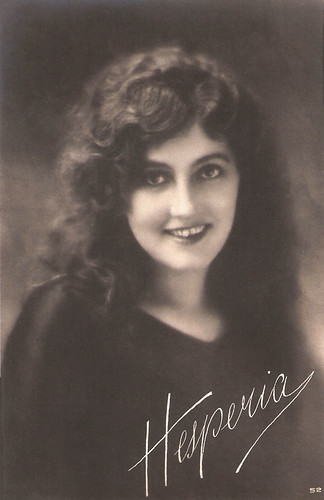
Romanian postcard by Edition S.A.R.P.I.C., Bucharest, no. 52.
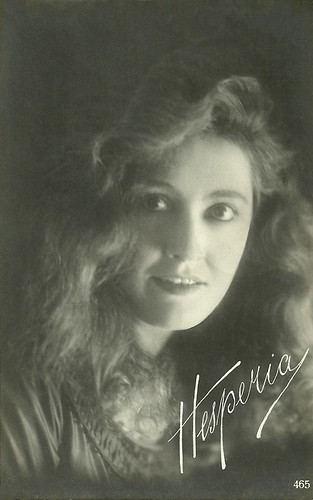
Italian postcard by Ed. A. Traldi, Milano, no. 465.
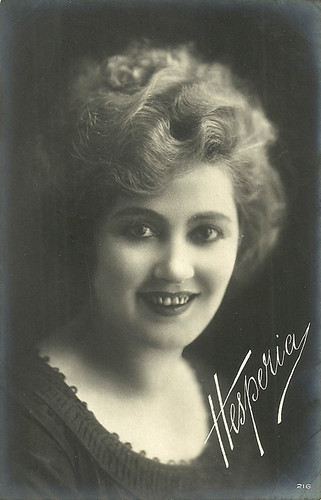
Italian postcard by Ed. Fotocelere, Torino, no. 216.
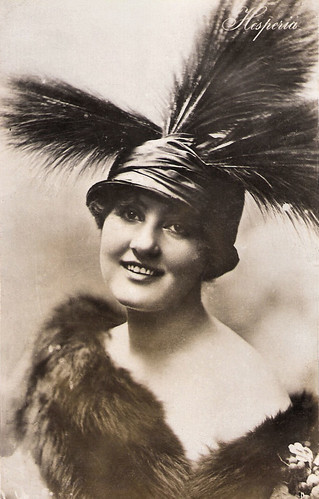
Spanish postcard by Leonar.
Tableaux Vivants
Hesperia was born as Olga Mambelli in 1885 in Bertinora, Italy. Her niece was film actress Pauline Polaire, who also appeared in Italian silent films.
Hesperia started her career as a child actor at the Teatro Comunale, the local theatre in Meldola in the Italian Romagna, where she grew up.
Between 1910 and 1912 she had her breakthrough as vaudeville artist with tableaux vivants of sculptures and paintings, performing all around Italy. Her parents considered her hence a dishonoured woman and closed the door to her.
Baron Fassini of the Roman Cines film company saw a future star in this quite matron like woman. He put her into films, first in two- and three-reelers, often paired with Ignazio Lupi .
Among these early films were silent shorts like Quando la donna vuole.../When the woman wants ... (N.N., 1912), Altruismo/Altruism (N.N., 1912), and La madre/The Mother (Baldassarre Negroni, 1913) with Leda Gys . Hesperia proved to be as well a good dramatic actress as a comedienne.
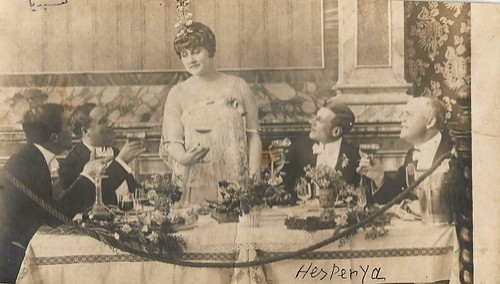
Possibly a Turkish or Egyptian postcard. Hesperia as Casque d'Or in Anime buie (Emilio Ghione, 1916). See also Silents please.
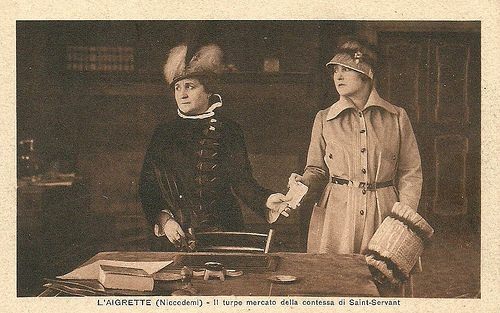
Italian postcard by IPA CT Duplex, no. 5105. Photo: Tiber Film, Roma. Hesperia and Ida Carloni Talli in L'aigrette (Baldassarre Negroni, 1917). This was an adaptation of a play by Dario Niccodemi. The countess of Saint-Servant ( Ida Carolini Talli ) has raised her son Enrico ( Tullio Carminati ) to be proud of his name and title, and to cherish honour and virtue, symbolised by the feather of her aigrette. In reality the countess is hunted by creditors, the castle is falling apart. Enrico falls in love with Susanne Leblanc (Hesperia), wife of banker, and in return she loads him with money in order to restore the castle. Her husband ( André Habay ) is not so happy with this kind of charity...
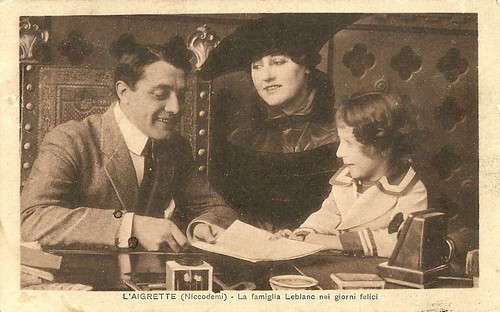
Italian postcard by IPA CT Duplex, no. 5107. Photo: Tiber Film, Roma. Hesperia and André Habay in L'aigrette (Baldassarre Negroni, 1917). Caption: 'The Leblanc family in happier days.'
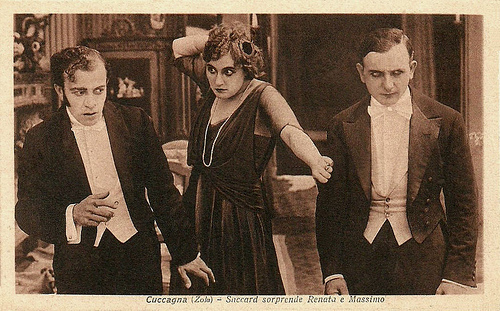
Italian postcard by Tiber Film, Roma, no. 5071. Photo: IPA CT Duplex.
Saccard (Claudio Nicola) surprises Renée (Hesperia) and Max ( Alberto Collo ) in La cuccagna (Baldassarre Negroni, 1917). The film was an adaptation of Emile Zola's 'La curée' (The Kill). Hesperia is Renata/Renée, second wife of the cunning and wealthy Saccard, who married young Renata for her money. She has an affair with Saccard's son Max, played by Collo. In the end money triumphs instead of love, just as in Zola's novel. On this postcard the father (left) looks not much older than the son (right).
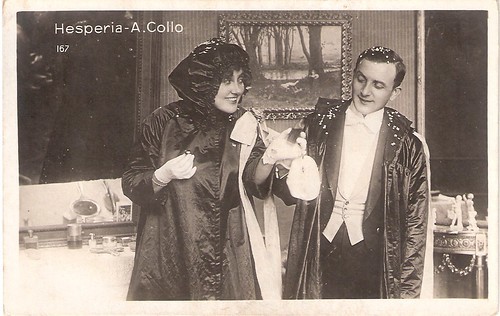
Italian postcard by Ed. Vettori, Bologna, no. 167. Hesperia and Alberto Collo in La cuccagna (Baldassarre Negroni, 1917). In the end, money triumphs instead of love, just as in Emile Zola's novel, 'La curée'. That's why some Italian critics thought the film title La cuccagna (Abundance) was too cheerful, while 'La curée' literally means 'The Loot' and the official English title of the novel is 'The Kill'.
Incontrollable Rages
In 1914, Hesperia switched to Milano-Films, with her future husband, film director Baldassarre Negroni. He had already been directing her at Cines. For a while he was also the artistic director at Milano.
Among their films for Milano were L'ultima battaglia/The Last Battle (Baldassarre Negroni, 1914) with Livio Pavanelli , Vizio atavico/Atavistic Vice (Baldassarre Negroni, 1914) starring Mercedes Brignone , and Nel nido straniero/Stranger in the nest (Baldassarre Negroni, 1914).
In 1915, when Italy joined the Allies in the First World War and Milano had to stop producing, Negroni took Hesperia with him to the Tiber Film company in Rome, where Francesca Bertini just had left for the Caesar company.
A strong competition between the two leading ladies started, exploiting both the typical diva repertory of boulevard drama, leading to simultaneous adaptations of Alexandre Dumas fils' 'La dame aux camélias' in 1915. While Bertini remained more solemn, Hesperia could get into uncontrollable rages but also wildly merry moods.
The following years, Hesperia appeared at Tiber-Film in such films as Marcella (Baldassarre Negroni, 1915) based on a play by Victorien Sardou, La morsa/The Vice (Emilio Ghione, 1916) and La donna di cuori/The queen of hearts (Baldassarre Negroni, 1917) wih Tullio Carminati .
Between 1912 and 1923, the year she married count Negroni and withdrew from film business, Hesperia made some 70 films, mostly impeccable and often popular bourgeois dramas and comedies.
Even later films such as Il figlio di Madame Sans-Gêne/The son of Madame Sans-Gêne (Baldassarre Negroni, 1921) with her niece Pauline Polaire knew to draw crowds in Italy.
In 1938, the by now countess Olga Negroni had a small reappearance on Italian screens in the film Orgoglio/Pride, (Marco Elter, 1938) starring Fosco Giachetti and shot at the Cinecittà film studios.
In 1959, Hesperia passed away in Rome, Italy. The countess was 73.
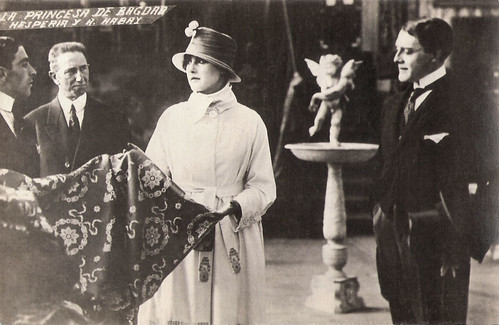
Spanish postcard. Hesperia and André Habay in La principessa di Bagdad/The Princess of Bagdad (Baldassarre Negroni, 1918).
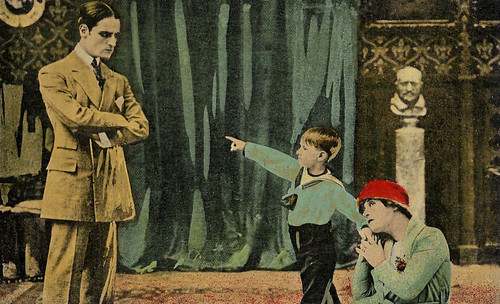
Spanish collectors card in the Colec. cromos cinematográficos by Chocolat Imperiale, no. 5 (in a serie of 6 cromos). Photo: Tiber-Film, Roma / J. Verdaguer, Barcelona. Hesperia in La principessa di Bagdad/The Princess of Bagdad (Baldassarre Negroni, 1918).
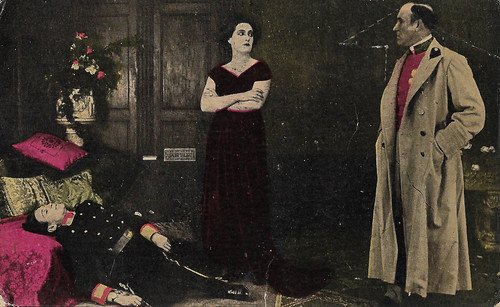
Spanish collectors card the Colec. cromos cinematográficos by Chocolat Imperial, Series of 6 'cromos', no. 1. Photo: Grandes Exclusivas Verdaguer / FAI. Hesperia and Giovanni Schettini (the man at left) in El Vertigo, Spanish title for the Italian silent drama Vertigine/Vertigo (Baldassarre Negroni, 1919). Unknown is who the man at right is.
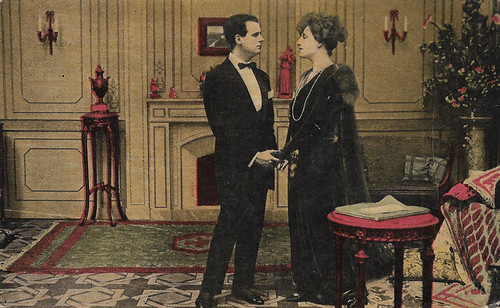
Spanish collectors card the Colec. cromos cinematográficos by Chocolat Imperial, Series of 6 'cromos', no. 5. Photo: Grandes Exclusivas Verdaguer / FAI. Hesperia and Tullio Carminati in Vertigine/Vertigo (Baldassarre Negroni, 1919).
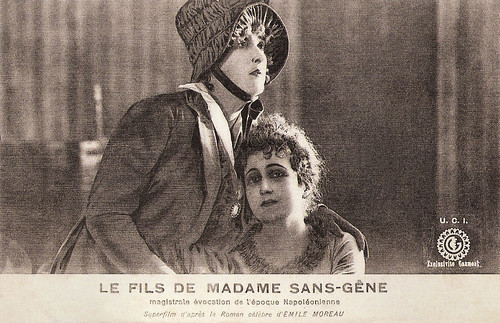
French postcard by Le Deley, Paris. Photo: U.C.I. / Gaumont / Tiber Film. Publicity still for the Italian silent film Il figlio di Madame Sans-Gêne (Baldassarre Negroni, 1921). Adapted from the novel by Emile Moreau. The women here may be Hesperia and Pauline Polaire (Mme Ambzac).
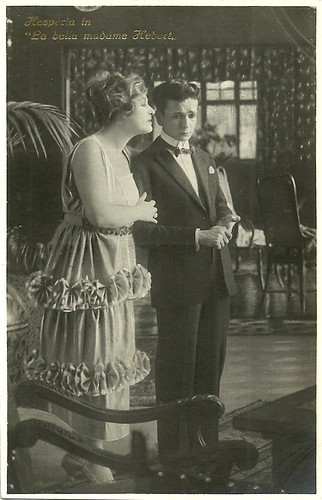
Italian postcard. Photo: Tiber Film. Hesperia and probably Carlo Troisi in La belle Madame Hebert (Baldassarre Negroni, 1922). The film was an adaptation of the homonymous French play by Abel Hermant.
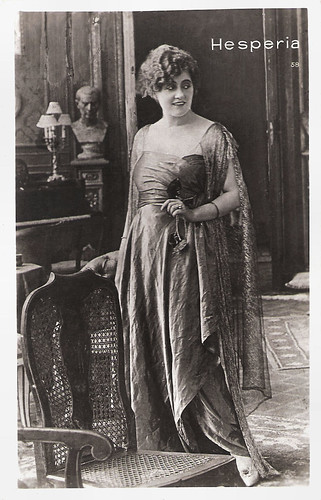
Italian postcard by Ed. G. Vettori, Bologna.
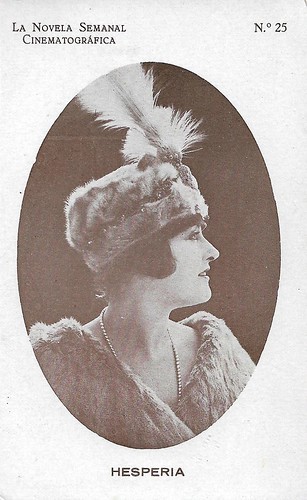
Spanish postcard by La novela semanal cinematografica, no. 25.
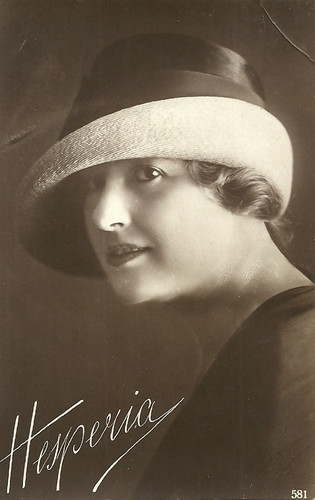
Italian postcard by Ed. A. Traldi, Milano, no. 581.
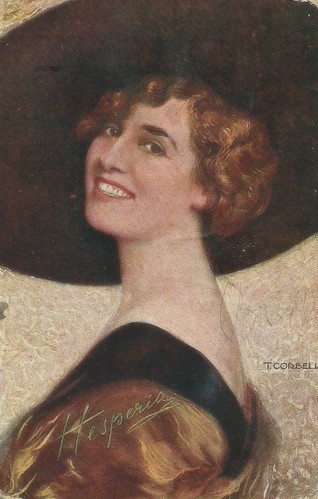
Italian postcard by Uff. Rev. Stampa, Milano, no. 229, 2-4-1917. Hesperia by Tito Corbella.
Source: Vittorio Martinelli, Le dive del silenzio; Tonino Simoncelli, Hesperia, stella del varietà e diva del muto (in Griffithiana, Issues 55-56), and .

Italian postcard by Ed. A. Traldi, Roma. Photo: Pinto, Roma.

Romanian postcard by Edition S.A.R.P.I.C., Bucharest, no. 52.

Italian postcard by Ed. A. Traldi, Milano, no. 465.

Italian postcard by Ed. Fotocelere, Torino, no. 216.

Spanish postcard by Leonar.
Tableaux Vivants
Hesperia was born as Olga Mambelli in 1885 in Bertinora, Italy. Her niece was film actress Pauline Polaire, who also appeared in Italian silent films.
Hesperia started her career as a child actor at the Teatro Comunale, the local theatre in Meldola in the Italian Romagna, where she grew up.
Between 1910 and 1912 she had her breakthrough as vaudeville artist with tableaux vivants of sculptures and paintings, performing all around Italy. Her parents considered her hence a dishonoured woman and closed the door to her.
Baron Fassini of the Roman Cines film company saw a future star in this quite matron like woman. He put her into films, first in two- and three-reelers, often paired with Ignazio Lupi .
Among these early films were silent shorts like Quando la donna vuole.../When the woman wants ... (N.N., 1912), Altruismo/Altruism (N.N., 1912), and La madre/The Mother (Baldassarre Negroni, 1913) with Leda Gys . Hesperia proved to be as well a good dramatic actress as a comedienne.

Possibly a Turkish or Egyptian postcard. Hesperia as Casque d'Or in Anime buie (Emilio Ghione, 1916). See also Silents please.

Italian postcard by IPA CT Duplex, no. 5105. Photo: Tiber Film, Roma. Hesperia and Ida Carloni Talli in L'aigrette (Baldassarre Negroni, 1917). This was an adaptation of a play by Dario Niccodemi. The countess of Saint-Servant ( Ida Carolini Talli ) has raised her son Enrico ( Tullio Carminati ) to be proud of his name and title, and to cherish honour and virtue, symbolised by the feather of her aigrette. In reality the countess is hunted by creditors, the castle is falling apart. Enrico falls in love with Susanne Leblanc (Hesperia), wife of banker, and in return she loads him with money in order to restore the castle. Her husband ( André Habay ) is not so happy with this kind of charity...

Italian postcard by IPA CT Duplex, no. 5107. Photo: Tiber Film, Roma. Hesperia and André Habay in L'aigrette (Baldassarre Negroni, 1917). Caption: 'The Leblanc family in happier days.'

Italian postcard by Tiber Film, Roma, no. 5071. Photo: IPA CT Duplex.
Saccard (Claudio Nicola) surprises Renée (Hesperia) and Max ( Alberto Collo ) in La cuccagna (Baldassarre Negroni, 1917). The film was an adaptation of Emile Zola's 'La curée' (The Kill). Hesperia is Renata/Renée, second wife of the cunning and wealthy Saccard, who married young Renata for her money. She has an affair with Saccard's son Max, played by Collo. In the end money triumphs instead of love, just as in Zola's novel. On this postcard the father (left) looks not much older than the son (right).

Italian postcard by Ed. Vettori, Bologna, no. 167. Hesperia and Alberto Collo in La cuccagna (Baldassarre Negroni, 1917). In the end, money triumphs instead of love, just as in Emile Zola's novel, 'La curée'. That's why some Italian critics thought the film title La cuccagna (Abundance) was too cheerful, while 'La curée' literally means 'The Loot' and the official English title of the novel is 'The Kill'.
Incontrollable Rages
In 1914, Hesperia switched to Milano-Films, with her future husband, film director Baldassarre Negroni. He had already been directing her at Cines. For a while he was also the artistic director at Milano.
Among their films for Milano were L'ultima battaglia/The Last Battle (Baldassarre Negroni, 1914) with Livio Pavanelli , Vizio atavico/Atavistic Vice (Baldassarre Negroni, 1914) starring Mercedes Brignone , and Nel nido straniero/Stranger in the nest (Baldassarre Negroni, 1914).
In 1915, when Italy joined the Allies in the First World War and Milano had to stop producing, Negroni took Hesperia with him to the Tiber Film company in Rome, where Francesca Bertini just had left for the Caesar company.
A strong competition between the two leading ladies started, exploiting both the typical diva repertory of boulevard drama, leading to simultaneous adaptations of Alexandre Dumas fils' 'La dame aux camélias' in 1915. While Bertini remained more solemn, Hesperia could get into uncontrollable rages but also wildly merry moods.
The following years, Hesperia appeared at Tiber-Film in such films as Marcella (Baldassarre Negroni, 1915) based on a play by Victorien Sardou, La morsa/The Vice (Emilio Ghione, 1916) and La donna di cuori/The queen of hearts (Baldassarre Negroni, 1917) wih Tullio Carminati .
Between 1912 and 1923, the year she married count Negroni and withdrew from film business, Hesperia made some 70 films, mostly impeccable and often popular bourgeois dramas and comedies.
Even later films such as Il figlio di Madame Sans-Gêne/The son of Madame Sans-Gêne (Baldassarre Negroni, 1921) with her niece Pauline Polaire knew to draw crowds in Italy.
In 1938, the by now countess Olga Negroni had a small reappearance on Italian screens in the film Orgoglio/Pride, (Marco Elter, 1938) starring Fosco Giachetti and shot at the Cinecittà film studios.
In 1959, Hesperia passed away in Rome, Italy. The countess was 73.

Spanish postcard. Hesperia and André Habay in La principessa di Bagdad/The Princess of Bagdad (Baldassarre Negroni, 1918).

Spanish collectors card in the Colec. cromos cinematográficos by Chocolat Imperiale, no. 5 (in a serie of 6 cromos). Photo: Tiber-Film, Roma / J. Verdaguer, Barcelona. Hesperia in La principessa di Bagdad/The Princess of Bagdad (Baldassarre Negroni, 1918).

Spanish collectors card the Colec. cromos cinematográficos by Chocolat Imperial, Series of 6 'cromos', no. 1. Photo: Grandes Exclusivas Verdaguer / FAI. Hesperia and Giovanni Schettini (the man at left) in El Vertigo, Spanish title for the Italian silent drama Vertigine/Vertigo (Baldassarre Negroni, 1919). Unknown is who the man at right is.

Spanish collectors card the Colec. cromos cinematográficos by Chocolat Imperial, Series of 6 'cromos', no. 5. Photo: Grandes Exclusivas Verdaguer / FAI. Hesperia and Tullio Carminati in Vertigine/Vertigo (Baldassarre Negroni, 1919).

French postcard by Le Deley, Paris. Photo: U.C.I. / Gaumont / Tiber Film. Publicity still for the Italian silent film Il figlio di Madame Sans-Gêne (Baldassarre Negroni, 1921). Adapted from the novel by Emile Moreau. The women here may be Hesperia and Pauline Polaire (Mme Ambzac).

Italian postcard. Photo: Tiber Film. Hesperia and probably Carlo Troisi in La belle Madame Hebert (Baldassarre Negroni, 1922). The film was an adaptation of the homonymous French play by Abel Hermant.

Italian postcard by Ed. G. Vettori, Bologna.

Spanish postcard by La novela semanal cinematografica, no. 25.

Italian postcard by Ed. A. Traldi, Milano, no. 581.

Italian postcard by Uff. Rev. Stampa, Milano, no. 229, 2-4-1917. Hesperia by Tito Corbella.
Source: Vittorio Martinelli, Le dive del silenzio; Tonino Simoncelli, Hesperia, stella del varietà e diva del muto (in Griffithiana, Issues 55-56), and .
Published on January 26, 2020 22:00
January 25, 2020
Stathis Giallelis
Stathis Giallelis (1941) is a Greek actor, who won brief international renown in the early 1960s as the star of Elia Kazan's immigrant epic America America (1963). He appears in nearly every scene of the 174-minute film and his "towering performance" brought him the Golden Globe Award for New Star of the Year – Actor, as well as a nomination for Golden Globe Award for Best Actor – Motion Picture Drama. However, he appeared in front of the camera only seven more times and retired from the cinema in 1983. The colourful Spanish cards in this post are a reminder of what a promising and popular international star Giallellis once was.
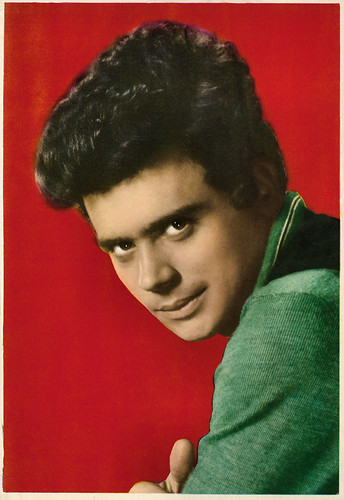
Spanish postcard by Archivo Bermejo, no. C-187, 1964. Photo: Warner Bros. Photo: Stathis Giallelis in America America (Elia Kazan, 1963).
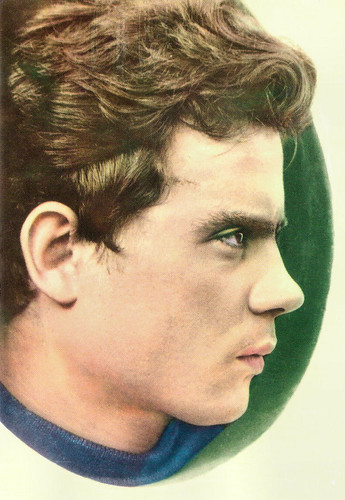
Spanish postcard by Toro de Bronche, no. 233. Photo: Warner Bros. Photo: Stathis Giallelis in America America (Elia Kazan, 1963).
Searching for verisimilitude
Stathis Giallelis or in Greek Στάθης Γιαλελής was born in 1941. The date of his birth is generally accepted as correct, according to Wikipedia , although two sources indicate 1939 as the year. All listings agree that he was born in Greece, but none specify the location.
The medium-height, slightly built Giallelis was twenty-one years old in mid-1962, upon Elia Kazan's arrival in Greece to meet the future star of his long-planned cinematic representation of his uncle's life in 1890s Anatolia and the eventual fulfilment of his determined dream of immigrating to the United States.
Kazan wanted an unknown actor in whom the audience would see the character rather than the familiar face. In his autobiography, 'Elia Kazan: A Life', the director describes the details of his search for "a ferret, not a lion", someone who, like his uncle, did not always behave honourably, but had "my boy's single redeeming quality, devotion to his father and family".
Kazan first tried to find his leading actor in England and, subsequently, in France, where a likely candidate was found, tested and rejected as "too handsome" and "lacking desperation" (although the actor was never named, circumstantial evidence points to Alain Delon ).
Even the Actors Studio proved deficient in providing the ideal aspirant. Finally, as he described it, "I did the obvious, went to Athens, and in the office a film director found an apprentice sweeping the floor so he could be near production work". This was the office of Greek producer/director Daniel Bourla, according to Kazan at Wikipedia .
However, in a 2017 interview with Alicia Malone, Giallellis remembered differently: "My grandmother’s school in Greece was actually where Elia Kazan found me. He would often say that he found me in a producer’s office sweeping the floor. He used to change the story a lot. He’d say, “The older you get the more the story changes.” He and I remained friends until the very end. In fact, the last few years of life, he was a recluse but we still managed to see each other every once in a while."
Stathis Giallelis was severely limited in both acting experience and knowledge of English. The only son in a family with four daughters, he nevertheless impressed Kazan with his sincerity and deeply felt reminiscences of his Communist father's martyrdom in the aftermath of the Communist–centrist/rightist struggle in the Greek Civil War.
Kazan continued to insist over the following decades that had the central role been played by a contemporary actor of the calibre of Marlon Brando or Warren Beatty (both of whom became stars under Kazan's direction) or one of the 1970s stars such as Dustin Hoffman , Al Pacino or Robert De Niro , the project would have lacked verisimilitude, even while enjoying much greater financial success. He compared Giallelis' performance to that of the protagonist in the Neorealist classic Ladri di biciclette/The Bicycle Thief (Vittorio De Sica, 1948).
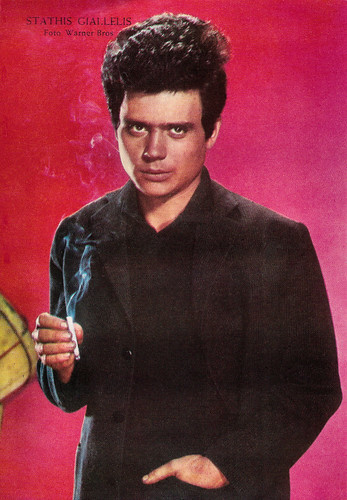
Spanish card. Photo: Warner Bros. Photo: Stathis Giallelis in America America (Elia Kazan, 1963).
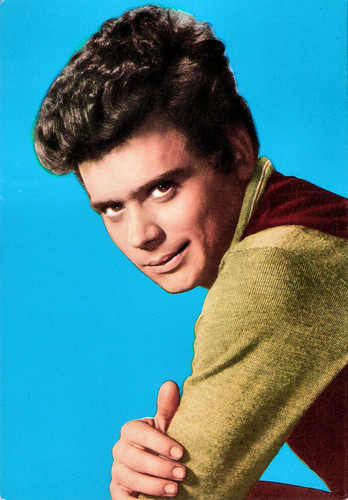
Spanish postcard by CyA, no. 53. Photo: Warner Bros. Photo: Stathis Giallelis in America America (Elia Kazan, 1963).
Putting fire and spirit into the role
Stathis Giallelis perfected his English-language skills as he spent nearly 18 months preparing for and filming his role, and the result was evident in the critical notices. The New York Times' Bosley Crowther, in his 1963 review of the film, noted that "Greek lad Stathis Giallelis (pronounced STAH-this-Ya-lah-LEASE) is incredibly good as the determined hero, putting fire and spirit into the role". Other critics called his performance "mesmerizing", "heartbreaking" and "unforgettable".
America America earned three Oscar nominations for Elia Kazan (Best Picture, Best Director and Best Original Screenplay), but its only win on Oscar night in 1964 was for Gene Callahan's black-and-white Art Direction. Eleven additional nominations came from other awards, including Golden Globes, which named Elia Kazan "Best Director" and Stathis Giallelis "Most Promising Male Newcomer/New Star of the Year", an award he shared with two of the remaining five nominees— Albert Finney and Robert Walker, Jr. He was also nominated for "Best Actor in a Drama", but lost to Sidney Poitier in his Oscar-winning Lilies of the Field role.
As America America received wide distribution in Europe and elsewhere in 1964-1965, Stathis Giallelis basked in the spotlight. In the months between the end of production and its December release, he completed a cameo role in the Greek art film Mikres Afrodites/Young Aphrodites (Nikos Koundouros, 1963).
Returning to Hollywood, the young actor seemed to be on the verge of a long and successful film career. Ultimately, however, in the 16-year period between 1964 and 1980, he appeared in front of the camera only seven more times in widely spaced film projects, only three of which (Cast a Giant Shadow, Blue and The Children of Sanchez) were American productions.
Giallelis' first post-America America film offer came shortly after the epic went into wide release during Christmas week of 1963. Leopoldo Torre Nilsson, Argentina's internationally best known filmmaker, whose hypocrisy- and corruption-themed films regularly received acclaim at European film festivals, invited him to star in his new project, El Ojo de la Cerradura/The Eavesdropper (Leopoldo Torre Nilsson, 1966). His co-star, and the only other non-Spanish speaker in the cast was twenty-one-year-old actress Janet Margolin who, two years earlier, had received critical praise for her co-starring role with Keir Dullea in Frank Perry's David and Lisa (1964).
Filmed in Buenos Aires, El Ojo de la Cerradura garnered encouraging notices at a number of film festivals and won the Silver Condor Best Film Award from the Argentine Film Critics Association. Two years later it received a belated release in U.S. art houses, including a September 1966 New York premiere. Despite good notices, it soon ended its run and has remained elusive.
In between he also appeared in the American produced war drama Act of Reprisal (Erricos Andreou, Robert Tronson, 1964), a love story set against the backdrop of Cyprus' struggle for independence from the British in the 1950s. The film starred Ina Balin and Jeremy Brett.
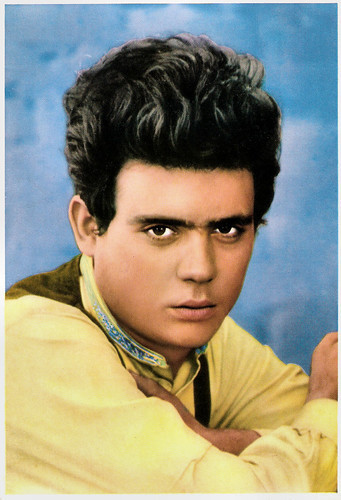
Spanish postcard by Archivo Bermejo, no. C-187, 1964. Photo: Warner Bros. Photo: Stathis Giallelis in America America (Elia Kazan, 1963).
Not leaving a strong impression
Stathis Giallelis' second 1966 U.S. release, Cast a Giant Shadow (Melville Shavelson, 1966) is the only title in his brief filmography structured as a major studio production. The all-star epic about a Jewish-American army officer's key leadership role in winning the battles which led to the 1948 establishment of Israel, found him fifth-billed after Kirk Douglas (as the central figure, Colonel Mickey Marcus), Senta Berger , Angie Dickinson and James Donald.
His role, as a dedicated Israeli fighter for independence, spotted him in various brief moments throughout the film, but did not leave a strong impression, according to Wikipedia . Despite its Hollywood pedigree, Cast a Giant Shadow was shot by director Melville Shavelson entirely on outdoor locations in Israel and Italy as well as studio interiors at Rome's Cinecittà studios.
Two more years would pass before Stathis Giallelis was seen in another film. Blue (Silvio Narizzano, 1968) was a well-budgeted independent Western filmed on picturesque Utah locations. Billed fourth after Terence Stamp (as "Azul" ["Blue" in Spanish]), Joanna Pettet and Karl Malden, Giallelis, as the son of Mexican bandit Ricardo Montalbán had little to show for his dramatic efforts and, with Montalban's 'Special guest' billing factored in, he actually was, again, in fifth place.
Wikipedia : "Released by Paramount, Blue was perceived by a number of critics as an anti-war allegory, specifically focusing on Vietnam. Saddled with a mostly negative response from the critics, the film was quickly out of theatres."
Some sources including IMDb credit Stathis Giallelis with a role in the Yugoslav-produced war film Rekvijem/Last Train to Berlin (Caslav Damjanovic, 1970), but his participation remains unconfirmed. The World War II heroics on display gave top billing to American Ty Hardin who at the time appeared in a number of European-made action films and Spaghetti Westerns. Rekvijem premiered in Yugoslavia in 1970 and, although it never had a U.S. release, it was later seen on television in a cut and dubbed version entitled Last Rampage.
In 1974, Jules Dassin and his wife Melina Mercouri used the donated services of many top entertainment personalities to produce The Rehearsal (Jules Dassin, 1974), an angry docudrama which reconstructed the events leading to the killing of some forty students in Athens, as they protested against the heavy-handed rule of the Greek Junta.
As a Greek living abroad, Stathis Giallelis was invited to participate along with Olympia Dukakis, Mikis Theodorakis and other celebrities of varying nationalities, such as Laurence Olivier and Maximilian Schell . Socially active writers, including Lillian Hellman and former Elia Kazan compatriot Arthur Miller also took rare acting turns in the production.
Filmed in a makeshift New York studio, the film was finished only days before the Junta's fall in July, and was thus set aside without public showings. Decades later, it received a brief New York premiere in 2001.
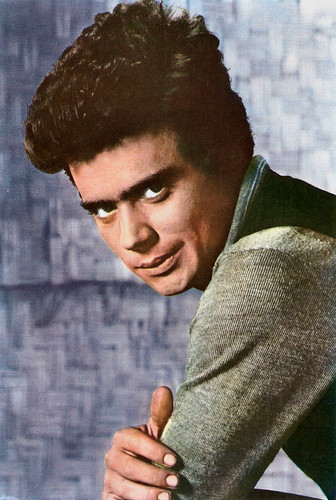
Spanish postcard by Raker, no. 1139, 1965. Photo: Warner Bros. Photo: Stathis Giallelis in America America (Elia Kazan, 1963).
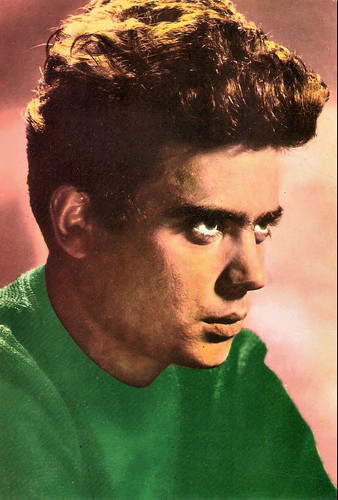
Spanish postcard by Toro de Bronche, no. 234. Photo: Warner Bros. Photo: Stathis Giallelis in America America (Elia Kazan, 1963).
Exiting the life of Hollywood glam
Now able to return to his homeland, Stathis Giallelis appeared in esteemed Greek director Pantelis Voulgaris' Nineteen Eighty-Four-like allegory Happy Day (Pantelis Voulgaris, 1974), playing one of the leads in the story about imprisonment and repression in an unspecified European-style society.
Having briefly been a Hollywood star in the previous decade, he was still seen as a celebrity in his homeland, but the film, despite receiving top awards at Greek film festivals in 1976 and a showing in Canada at the 1977 Toronto Festival of Festivals, had little impact on his career.
After a passage of another two years, Giallelis appeared in his last-to-date American film, The Children of Sanchez (Hall Bartlett, 1978). This adaptation of the Oscar Lewis novel was filmed on location in Mexico and starred native-born Anthony Quinn as his country's putative everyman, Jesus Sanchez. Giallelis received yet another fifth billing, following two veteran Mexican actresses, Dolores del Río and Katy Jurado, as well as Venezuelan Lupita Ferrer who, at the time, was married to Hall Bartlett.
Wikipedia : "Gialellis's role as Roberto was relatively small and underwritten, but he did receive a couple of closeups, which showed premature aging on the 37-year-old actor's once-youthful face." Upon its Los Angeles premiere in 1978, the film received mixed to poor reviews, with the primary attention going to Chuck Mangione's lively score.
In the Italian TV miniseries, Panagulis vive/Panagoulis Lives (Giuseppe Ferrara, 1980), which examined the life and death of Greece's renowned martyred poet-politician/democracy activist Alexandros Panagoulis, the title role went to Giallelis, whose ethnicity, still-remaining international fame, and age (a year-and-a-half younger than Panagoulis) made him a natural candidate for the part. Heading a large cast, he received generally favourable reviews.
IMDb mentions one further film in which Giallellis played the leading role, the Greek production To tragoudi tis epistrofis/Homecoming Song (Yannis Smaragdis, 1983). The film was nominated for the Golden Prize at the Moscow International Film Festival.
After his years as an award-winning actor, Stathis Giallelis exited the life of Hollywood glam and went to work at the United Nations International School in Manhattan, New York, working as a child supervisor and mentor. He retired in the summer of 2008. IMDb mentions also that he married Joan Brecher in 1967.
Forgotten for many decades, America America (Elia Kazan, 1963) burst back to the big screen in 2011 at Il Cinema Ritrovato in Bologna and was later also presented in the US at the 2017 TCM Classic Film Festival. More than 50 years after the film had its premiere, America America still remains a stirring epic on the immigrant's role in American culture.
Trailer for America America (1963). Source: Jo Xiokas (YouTube).
German director Fatih Akin and Stathis Giallelis present America, America (1963) at the at Il Cinema Ritrovato 2011 in Bologna. Source: Cineteca Bologna (YouTube).
Sources: Ryan Williams (Movie Maker), Wikipedia and .

Spanish postcard by Archivo Bermejo, no. C-187, 1964. Photo: Warner Bros. Photo: Stathis Giallelis in America America (Elia Kazan, 1963).

Spanish postcard by Toro de Bronche, no. 233. Photo: Warner Bros. Photo: Stathis Giallelis in America America (Elia Kazan, 1963).
Searching for verisimilitude
Stathis Giallelis or in Greek Στάθης Γιαλελής was born in 1941. The date of his birth is generally accepted as correct, according to Wikipedia , although two sources indicate 1939 as the year. All listings agree that he was born in Greece, but none specify the location.
The medium-height, slightly built Giallelis was twenty-one years old in mid-1962, upon Elia Kazan's arrival in Greece to meet the future star of his long-planned cinematic representation of his uncle's life in 1890s Anatolia and the eventual fulfilment of his determined dream of immigrating to the United States.
Kazan wanted an unknown actor in whom the audience would see the character rather than the familiar face. In his autobiography, 'Elia Kazan: A Life', the director describes the details of his search for "a ferret, not a lion", someone who, like his uncle, did not always behave honourably, but had "my boy's single redeeming quality, devotion to his father and family".
Kazan first tried to find his leading actor in England and, subsequently, in France, where a likely candidate was found, tested and rejected as "too handsome" and "lacking desperation" (although the actor was never named, circumstantial evidence points to Alain Delon ).
Even the Actors Studio proved deficient in providing the ideal aspirant. Finally, as he described it, "I did the obvious, went to Athens, and in the office a film director found an apprentice sweeping the floor so he could be near production work". This was the office of Greek producer/director Daniel Bourla, according to Kazan at Wikipedia .
However, in a 2017 interview with Alicia Malone, Giallellis remembered differently: "My grandmother’s school in Greece was actually where Elia Kazan found me. He would often say that he found me in a producer’s office sweeping the floor. He used to change the story a lot. He’d say, “The older you get the more the story changes.” He and I remained friends until the very end. In fact, the last few years of life, he was a recluse but we still managed to see each other every once in a while."
Stathis Giallelis was severely limited in both acting experience and knowledge of English. The only son in a family with four daughters, he nevertheless impressed Kazan with his sincerity and deeply felt reminiscences of his Communist father's martyrdom in the aftermath of the Communist–centrist/rightist struggle in the Greek Civil War.
Kazan continued to insist over the following decades that had the central role been played by a contemporary actor of the calibre of Marlon Brando or Warren Beatty (both of whom became stars under Kazan's direction) or one of the 1970s stars such as Dustin Hoffman , Al Pacino or Robert De Niro , the project would have lacked verisimilitude, even while enjoying much greater financial success. He compared Giallelis' performance to that of the protagonist in the Neorealist classic Ladri di biciclette/The Bicycle Thief (Vittorio De Sica, 1948).

Spanish card. Photo: Warner Bros. Photo: Stathis Giallelis in America America (Elia Kazan, 1963).

Spanish postcard by CyA, no. 53. Photo: Warner Bros. Photo: Stathis Giallelis in America America (Elia Kazan, 1963).
Putting fire and spirit into the role
Stathis Giallelis perfected his English-language skills as he spent nearly 18 months preparing for and filming his role, and the result was evident in the critical notices. The New York Times' Bosley Crowther, in his 1963 review of the film, noted that "Greek lad Stathis Giallelis (pronounced STAH-this-Ya-lah-LEASE) is incredibly good as the determined hero, putting fire and spirit into the role". Other critics called his performance "mesmerizing", "heartbreaking" and "unforgettable".
America America earned three Oscar nominations for Elia Kazan (Best Picture, Best Director and Best Original Screenplay), but its only win on Oscar night in 1964 was for Gene Callahan's black-and-white Art Direction. Eleven additional nominations came from other awards, including Golden Globes, which named Elia Kazan "Best Director" and Stathis Giallelis "Most Promising Male Newcomer/New Star of the Year", an award he shared with two of the remaining five nominees— Albert Finney and Robert Walker, Jr. He was also nominated for "Best Actor in a Drama", but lost to Sidney Poitier in his Oscar-winning Lilies of the Field role.
As America America received wide distribution in Europe and elsewhere in 1964-1965, Stathis Giallelis basked in the spotlight. In the months between the end of production and its December release, he completed a cameo role in the Greek art film Mikres Afrodites/Young Aphrodites (Nikos Koundouros, 1963).
Returning to Hollywood, the young actor seemed to be on the verge of a long and successful film career. Ultimately, however, in the 16-year period between 1964 and 1980, he appeared in front of the camera only seven more times in widely spaced film projects, only three of which (Cast a Giant Shadow, Blue and The Children of Sanchez) were American productions.
Giallelis' first post-America America film offer came shortly after the epic went into wide release during Christmas week of 1963. Leopoldo Torre Nilsson, Argentina's internationally best known filmmaker, whose hypocrisy- and corruption-themed films regularly received acclaim at European film festivals, invited him to star in his new project, El Ojo de la Cerradura/The Eavesdropper (Leopoldo Torre Nilsson, 1966). His co-star, and the only other non-Spanish speaker in the cast was twenty-one-year-old actress Janet Margolin who, two years earlier, had received critical praise for her co-starring role with Keir Dullea in Frank Perry's David and Lisa (1964).
Filmed in Buenos Aires, El Ojo de la Cerradura garnered encouraging notices at a number of film festivals and won the Silver Condor Best Film Award from the Argentine Film Critics Association. Two years later it received a belated release in U.S. art houses, including a September 1966 New York premiere. Despite good notices, it soon ended its run and has remained elusive.
In between he also appeared in the American produced war drama Act of Reprisal (Erricos Andreou, Robert Tronson, 1964), a love story set against the backdrop of Cyprus' struggle for independence from the British in the 1950s. The film starred Ina Balin and Jeremy Brett.

Spanish postcard by Archivo Bermejo, no. C-187, 1964. Photo: Warner Bros. Photo: Stathis Giallelis in America America (Elia Kazan, 1963).
Not leaving a strong impression
Stathis Giallelis' second 1966 U.S. release, Cast a Giant Shadow (Melville Shavelson, 1966) is the only title in his brief filmography structured as a major studio production. The all-star epic about a Jewish-American army officer's key leadership role in winning the battles which led to the 1948 establishment of Israel, found him fifth-billed after Kirk Douglas (as the central figure, Colonel Mickey Marcus), Senta Berger , Angie Dickinson and James Donald.
His role, as a dedicated Israeli fighter for independence, spotted him in various brief moments throughout the film, but did not leave a strong impression, according to Wikipedia . Despite its Hollywood pedigree, Cast a Giant Shadow was shot by director Melville Shavelson entirely on outdoor locations in Israel and Italy as well as studio interiors at Rome's Cinecittà studios.
Two more years would pass before Stathis Giallelis was seen in another film. Blue (Silvio Narizzano, 1968) was a well-budgeted independent Western filmed on picturesque Utah locations. Billed fourth after Terence Stamp (as "Azul" ["Blue" in Spanish]), Joanna Pettet and Karl Malden, Giallelis, as the son of Mexican bandit Ricardo Montalbán had little to show for his dramatic efforts and, with Montalban's 'Special guest' billing factored in, he actually was, again, in fifth place.
Wikipedia : "Released by Paramount, Blue was perceived by a number of critics as an anti-war allegory, specifically focusing on Vietnam. Saddled with a mostly negative response from the critics, the film was quickly out of theatres."
Some sources including IMDb credit Stathis Giallelis with a role in the Yugoslav-produced war film Rekvijem/Last Train to Berlin (Caslav Damjanovic, 1970), but his participation remains unconfirmed. The World War II heroics on display gave top billing to American Ty Hardin who at the time appeared in a number of European-made action films and Spaghetti Westerns. Rekvijem premiered in Yugoslavia in 1970 and, although it never had a U.S. release, it was later seen on television in a cut and dubbed version entitled Last Rampage.
In 1974, Jules Dassin and his wife Melina Mercouri used the donated services of many top entertainment personalities to produce The Rehearsal (Jules Dassin, 1974), an angry docudrama which reconstructed the events leading to the killing of some forty students in Athens, as they protested against the heavy-handed rule of the Greek Junta.
As a Greek living abroad, Stathis Giallelis was invited to participate along with Olympia Dukakis, Mikis Theodorakis and other celebrities of varying nationalities, such as Laurence Olivier and Maximilian Schell . Socially active writers, including Lillian Hellman and former Elia Kazan compatriot Arthur Miller also took rare acting turns in the production.
Filmed in a makeshift New York studio, the film was finished only days before the Junta's fall in July, and was thus set aside without public showings. Decades later, it received a brief New York premiere in 2001.

Spanish postcard by Raker, no. 1139, 1965. Photo: Warner Bros. Photo: Stathis Giallelis in America America (Elia Kazan, 1963).

Spanish postcard by Toro de Bronche, no. 234. Photo: Warner Bros. Photo: Stathis Giallelis in America America (Elia Kazan, 1963).
Exiting the life of Hollywood glam
Now able to return to his homeland, Stathis Giallelis appeared in esteemed Greek director Pantelis Voulgaris' Nineteen Eighty-Four-like allegory Happy Day (Pantelis Voulgaris, 1974), playing one of the leads in the story about imprisonment and repression in an unspecified European-style society.
Having briefly been a Hollywood star in the previous decade, he was still seen as a celebrity in his homeland, but the film, despite receiving top awards at Greek film festivals in 1976 and a showing in Canada at the 1977 Toronto Festival of Festivals, had little impact on his career.
After a passage of another two years, Giallelis appeared in his last-to-date American film, The Children of Sanchez (Hall Bartlett, 1978). This adaptation of the Oscar Lewis novel was filmed on location in Mexico and starred native-born Anthony Quinn as his country's putative everyman, Jesus Sanchez. Giallelis received yet another fifth billing, following two veteran Mexican actresses, Dolores del Río and Katy Jurado, as well as Venezuelan Lupita Ferrer who, at the time, was married to Hall Bartlett.
Wikipedia : "Gialellis's role as Roberto was relatively small and underwritten, but he did receive a couple of closeups, which showed premature aging on the 37-year-old actor's once-youthful face." Upon its Los Angeles premiere in 1978, the film received mixed to poor reviews, with the primary attention going to Chuck Mangione's lively score.
In the Italian TV miniseries, Panagulis vive/Panagoulis Lives (Giuseppe Ferrara, 1980), which examined the life and death of Greece's renowned martyred poet-politician/democracy activist Alexandros Panagoulis, the title role went to Giallelis, whose ethnicity, still-remaining international fame, and age (a year-and-a-half younger than Panagoulis) made him a natural candidate for the part. Heading a large cast, he received generally favourable reviews.
IMDb mentions one further film in which Giallellis played the leading role, the Greek production To tragoudi tis epistrofis/Homecoming Song (Yannis Smaragdis, 1983). The film was nominated for the Golden Prize at the Moscow International Film Festival.
After his years as an award-winning actor, Stathis Giallelis exited the life of Hollywood glam and went to work at the United Nations International School in Manhattan, New York, working as a child supervisor and mentor. He retired in the summer of 2008. IMDb mentions also that he married Joan Brecher in 1967.
Forgotten for many decades, America America (Elia Kazan, 1963) burst back to the big screen in 2011 at Il Cinema Ritrovato in Bologna and was later also presented in the US at the 2017 TCM Classic Film Festival. More than 50 years after the film had its premiere, America America still remains a stirring epic on the immigrant's role in American culture.
Trailer for America America (1963). Source: Jo Xiokas (YouTube).
German director Fatih Akin and Stathis Giallelis present America, America (1963) at the at Il Cinema Ritrovato 2011 in Bologna. Source: Cineteca Bologna (YouTube).
Sources: Ryan Williams (Movie Maker), Wikipedia and .
Published on January 25, 2020 22:00
January 24, 2020
Silent Italian comedy
Ivo Blom wrote ‘All the Same or Strategies of Difference: Early Italian Comedy in International Perspective’, an article about the silent Italian comedy, published in Italian Silent Cinema. A Reader. You can now read Ivo's interesting article at his website. What were the characterisations of and differences between the typical comedians of the early Italian cinema like Cretinetti, Polidor, Kri-Kri and Robinet? And which were the differences between slapstick and situational comedy such as the Morano-Rodolfi comedies by Ambrosio? Ivo also compares the Italian silent comedies with its French and American counterparts at Pathé, Gaumont and Vitagraph. The online publication of the article matches EYE’s wonderful recent upload of several Italian silent comedies from the Desmet Collection at YouTube. For EFSP, Ivo made this selection from our collections with vintage postcards of Italian silent comedians and comedies.
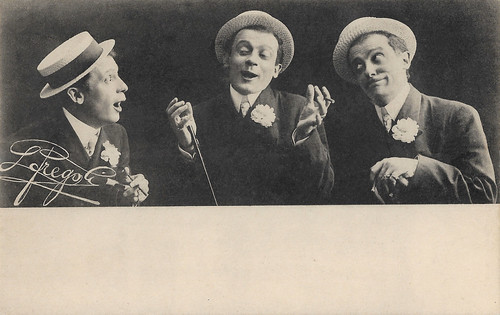
Italian postcard by Garzini e Pezzini, Milano, 1908.
Leopoldo Fregoli (1867-1936) was one of the first vaudeville actors who used film in his acts. Fregoli was famous for his rapid transformation acts, in which he did impersonations of famous artistic and political characters. In 1898 he bought a Cinematographe from the Lumière brothers and started to show shorts, named Fregoligraph, as part of his stage act. These were recordings of his transformation acts.

French postcard by Edition Pathé Frères. Photo: X.
One the most popular comedians in the French and the Italian silent cinema was André Deed (1879-1940) who was known under the names of Boireau and Cretinetti. In 1908, the Torinese company Itala lured him from Pathé to Italy, where Deed started the series of Cretinetti (‘little stupid’). He not only acted, but also directed his films. Deed behaved in a quite anarchic way, creating destruction and pursuits allover. Between 1909 and 1911 and between 1915 and 1920 Deed made 90 shorts with Cretinetti, such as the absurdist Cretinetti e le donne (1910), in which fanatic women tear the man to pieces. In the end all his loose limbs gather again.

French postcard. Photo: Pathé. Caption: M[ademoise]lle Frascaroli.
Valentina Frascaroli (1890-1955) was an Italian actress of the silent screen. After a training in dance and acting, she performed on stage. In 1909 she was hired by Itala Film, first as a screenwriter, then as actress. At Itala, she became the beloved companion of former Pathé comedian André Deed , known in Italy as Cretinetti and in France as Gribouille. She followed him to France when he returned to Pathé, now as Boireau. Frascaroli also had her own comedies there as the character Griboulette. Between 1915 and 1922 she acted in many, mostly dramatic Italian films such as Maciste alpino (1916), Tigre reale (1916), La guerra e il sogno di Momi (1917), etc. - mostly at Itala Film. Already in the early 1910s, she had acted opposite Ermete Zacconi in Padre (1912) and would be paired with him again in L'emigrante (1915). Frascaroli retired form the screen in 1925 but continued to perform on stage.
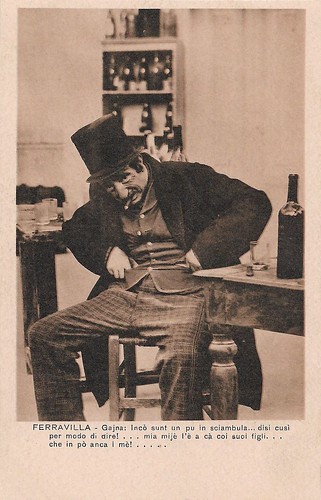
Italian postcard by IPA CT Duplex, no. 5899. Photo Comerio, Milano. V. Uff. Rev. St. Terni. Edoardo Ferravilla in Tecoppa & c.. Caption (in Milanese dialect): Gajna: I am a bit in shambles, so to say! My wife is at home with her children, which are a bit also mine! Ferravilla here performs his character Tecoppa.
Edoardo Ferravilla (1846-1915) was an actor and playwright of the Italian stage and silent screen. He performed in Milanese dialect and became the darling of the Italian public. Between 1913 and 1915, Ferravilla also had a short but successful film career. He thus immortalised some of his most popular sketches, and linked the early cinema to the repertoire of an ancient stage tradition.
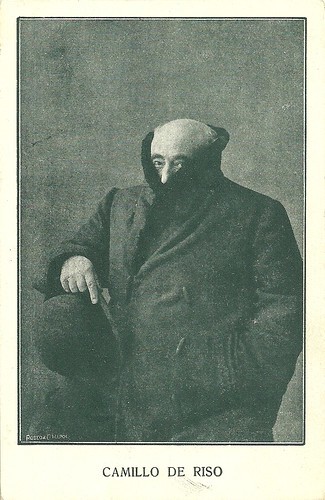
Italian postcard by Magazine Film - corriere dei cinematografici, Napoli / Roma. Photo Roseo & Co, Naples / Caesar Film.
Italian screen and stage actor and director Camillo De Riso (1854-1924) was most famous for his comedies at the companies Ambrosio, Gloria and Caesar. In 1912 he was hired by Ambrosio Film in Turin, where he formed a successful trio with Gigetta Morano and Eleuterio Rodolfi , contributing with his rotund face, small size and generous look of bourgeois bonhomme. Examples are Un successo diplomatico and L’oca alla Colbert, both 1913 and both directed by Rodolfi. The films of the trio were often based on Italian and French fin de siecle pochades and grew in length over the years. In late 1913, De Riso started at the Gloria company. Here he created the gay epicure and shameless libertine character of ‘Camillo’, and directed himself in a series of comical shorts between 1913 and 1914.
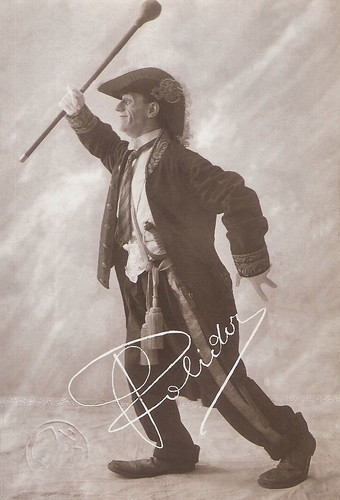
Italian postcard by Tip. Sent by mail in 1922.
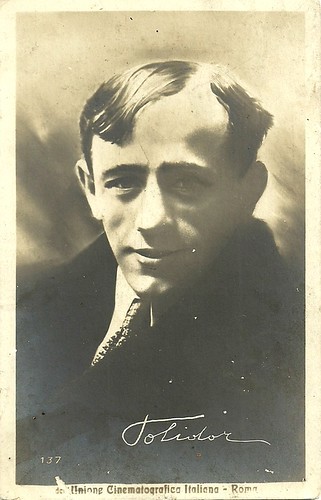
Italian postcard by La Rotofotografica / Unione Cinematografica Italiana, no. 137.
Italian comical actor Ferdinand Guillaume (1887-1977) was famous in the 1910s as Tontolini and as Polidor. He was enrolled by the Cines company in 1910 together with his brother Natale and their wives. Guillaume was launched as the character Tontolini, in 1912 also known in Britain and the US as Jenkins. Guillaume provided Cines and Italy an international reputation in the field of comedies. Actress Lea Giunchi, who was married to Natale (Natalino) Guillaume, often played as 'Lea' in the Tontolini comedies. Later she became the regular film partner of Kri-Kri (Raymond Frau), who more or less substituted Guillaume when the latter moved over to Pasquali. After some 100 shorts as Tontolini, and after the success of his first feature-length film, Pinocchio (Giulio Antamoro, 1911), Ferdinand Guillaume went over to the Pasquali company. Here he created the character of Polidor named after a horse in his old circus shows. From 1912 till 1914, he shot some 100 Polidor films, which were distributed all over Europe and the US.
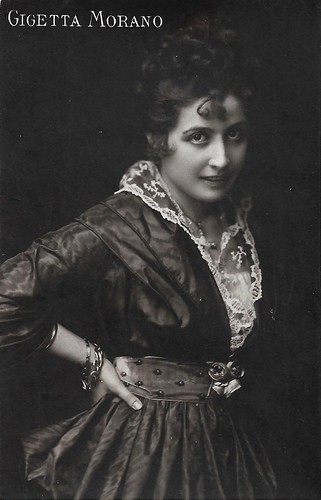
Italian postcard by Fotocelere.
Italian actress Luigia 'Gigetta' Morano (1887–1986) was very popular as a comedian in the early 1910s at the Ambrosio film studio. She had her own comic series with the type Gigetta. Together with Eleuterio Rodolfi , her partner on screen and her most prolific director, she did countless comedies, both shorts and longer films. At Ambrosio, she also acted in dramatic parts, e.g. as Lucia in I promessi sposi (Eleuterio Rodolfi, 1913).
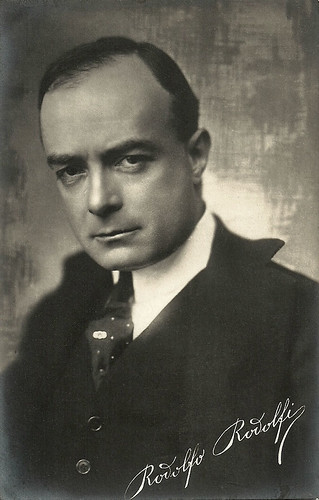
Italian postcard by Fotocelere.
Eleuterio Rodolfi (1876-1933) was an Italian actor, director and scriptwriter, who was highly active in the Italian silent cinema. For Ambrosio, Rodolfi acted in some 95 films of which some 80 ones were directed and scripted by himself. Many of these were comedies in which Rodolfi and Gigetta Morano played ‘Gigetta’ and ‘Rodolfi’. In contrast to the previous ‘comiche’ the anarchist farces by Cretinetti and others focused on speed and havoc, the comedies with Gigetta and Rodolfi were true ‘commedie’, so more situational, boulevardier, less speedy, and often hinting at forbidden fruits and voyeurism.
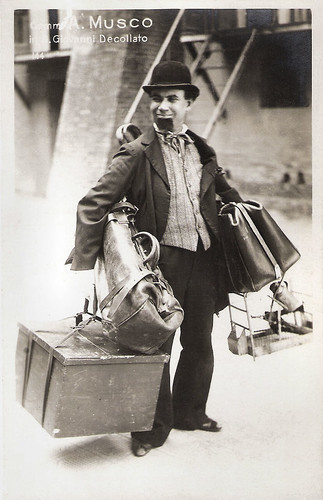
Italian postcard by Ed. Vettori, Bolgna. Angelo Musco in San Giovanni Decollato (Telemaco Ruggeri, 1917).
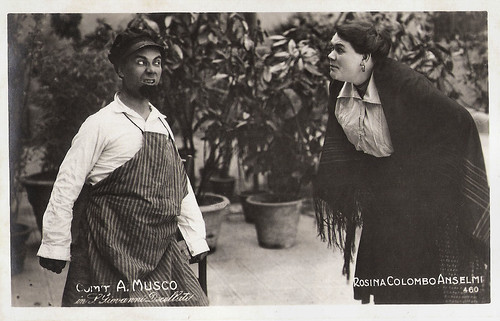
Italian postcard. This could be a postcard for either the film San Giovanni Decollato (Telemaco Ruggeri, 1917) or the play by Nino Martoglio on which it was based and which he had written for Musco. Angelo Musco (1872-1937) played in both film and stageplay. The woman on this card could be Rosina Anselmi, playing Musco's wife. All the actors in the play repeated their roles in Ruggeri's film, and Martoglio scripted the film too.
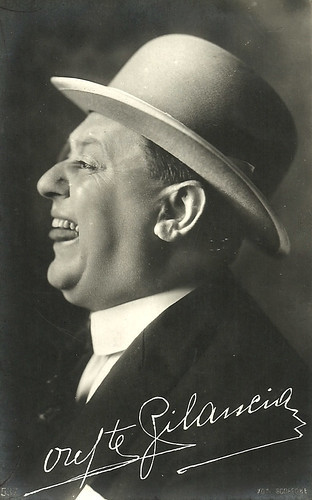
Italian postcard. Photo Scorrone.
Italian stage and film actor Oreste Bilancia (1881-1945) was highly active in Italian silent and sound cinema and also in the late silent cinema of the Weimar republic. He mostly worked as supporting actor, but occasionally he played the main character. The rotund Bilancia, often wearing a monocle, represented the bonvivant and gentleman in many Italian silent films. In the 1930s and early 1940s Bilancia acted in many Italian comedies, a.o. with Erminio Macario.
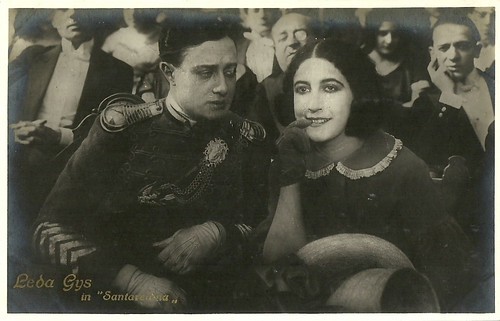
Italian postcard by G.B. Falci, Milano, no. 322. Photo: Leda Gys in the comedy Santarellina (Eugenio Perego, 1923).
Film diva Leda Gys (1892-1957) starred in ca. 60 dramas, comedies, thrillers and even Westerns of the Italian and Spanish silent cinema. Her claim to fame came with the film Christus (1916), shot in Egypt and Palestine, where Gys performed the Madonna.
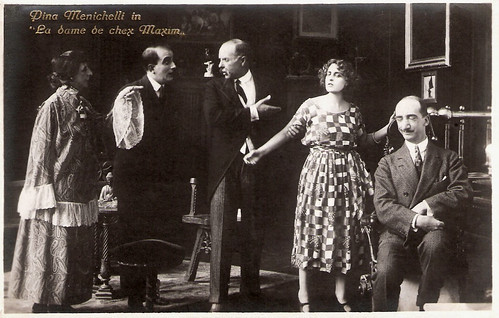
Italian postcard by Ed. G.B. Falci, Milano. Pina Menichelli and Marcel Lévesque in La dame de Chez Maxim's (Amleto Palermi, 1923).
The comedy La dame de Chez Maxim's was one of diva Pina Menichelli 's last films. With this film and with Occupati d'Amelia (Telemaco Ruggeri, 1925), both adaptations of popular Georges Feydeau boulevard comedies, Menichelli proved she was well able to do comedy and not only melodramatic and 'vampy' films. In both films one of her co-stars was the French comedian Marcel Lévesque, on the far right on this card.
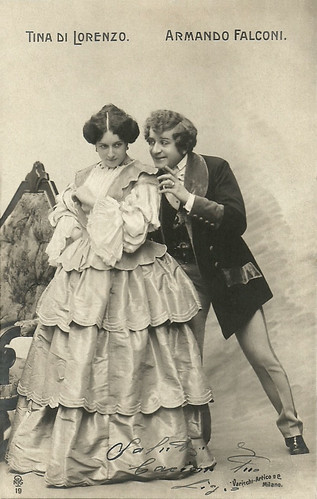
Italian postcard by NPC, no. 19. Photo: Varischi Artico & Co., Milano.
Though he was foremost a theatre actor and comedian, Armando Falconi (1871-1954) had a prolific career as comedian in Italian cinema of the 1930s and early 1940s. He was married to the famous stage actress Tina Di Lorenzo, with whom he also often acted together.

Italian postcard by Garzini e Pezzini, Milano, 1908.
Leopoldo Fregoli (1867-1936) was one of the first vaudeville actors who used film in his acts. Fregoli was famous for his rapid transformation acts, in which he did impersonations of famous artistic and political characters. In 1898 he bought a Cinematographe from the Lumière brothers and started to show shorts, named Fregoligraph, as part of his stage act. These were recordings of his transformation acts.

French postcard by Edition Pathé Frères. Photo: X.
One the most popular comedians in the French and the Italian silent cinema was André Deed (1879-1940) who was known under the names of Boireau and Cretinetti. In 1908, the Torinese company Itala lured him from Pathé to Italy, where Deed started the series of Cretinetti (‘little stupid’). He not only acted, but also directed his films. Deed behaved in a quite anarchic way, creating destruction and pursuits allover. Between 1909 and 1911 and between 1915 and 1920 Deed made 90 shorts with Cretinetti, such as the absurdist Cretinetti e le donne (1910), in which fanatic women tear the man to pieces. In the end all his loose limbs gather again.

French postcard. Photo: Pathé. Caption: M[ademoise]lle Frascaroli.
Valentina Frascaroli (1890-1955) was an Italian actress of the silent screen. After a training in dance and acting, she performed on stage. In 1909 she was hired by Itala Film, first as a screenwriter, then as actress. At Itala, she became the beloved companion of former Pathé comedian André Deed , known in Italy as Cretinetti and in France as Gribouille. She followed him to France when he returned to Pathé, now as Boireau. Frascaroli also had her own comedies there as the character Griboulette. Between 1915 and 1922 she acted in many, mostly dramatic Italian films such as Maciste alpino (1916), Tigre reale (1916), La guerra e il sogno di Momi (1917), etc. - mostly at Itala Film. Already in the early 1910s, she had acted opposite Ermete Zacconi in Padre (1912) and would be paired with him again in L'emigrante (1915). Frascaroli retired form the screen in 1925 but continued to perform on stage.

Italian postcard by IPA CT Duplex, no. 5899. Photo Comerio, Milano. V. Uff. Rev. St. Terni. Edoardo Ferravilla in Tecoppa & c.. Caption (in Milanese dialect): Gajna: I am a bit in shambles, so to say! My wife is at home with her children, which are a bit also mine! Ferravilla here performs his character Tecoppa.
Edoardo Ferravilla (1846-1915) was an actor and playwright of the Italian stage and silent screen. He performed in Milanese dialect and became the darling of the Italian public. Between 1913 and 1915, Ferravilla also had a short but successful film career. He thus immortalised some of his most popular sketches, and linked the early cinema to the repertoire of an ancient stage tradition.

Italian postcard by Magazine Film - corriere dei cinematografici, Napoli / Roma. Photo Roseo & Co, Naples / Caesar Film.
Italian screen and stage actor and director Camillo De Riso (1854-1924) was most famous for his comedies at the companies Ambrosio, Gloria and Caesar. In 1912 he was hired by Ambrosio Film in Turin, where he formed a successful trio with Gigetta Morano and Eleuterio Rodolfi , contributing with his rotund face, small size and generous look of bourgeois bonhomme. Examples are Un successo diplomatico and L’oca alla Colbert, both 1913 and both directed by Rodolfi. The films of the trio were often based on Italian and French fin de siecle pochades and grew in length over the years. In late 1913, De Riso started at the Gloria company. Here he created the gay epicure and shameless libertine character of ‘Camillo’, and directed himself in a series of comical shorts between 1913 and 1914.

Italian postcard by Tip. Sent by mail in 1922.

Italian postcard by La Rotofotografica / Unione Cinematografica Italiana, no. 137.
Italian comical actor Ferdinand Guillaume (1887-1977) was famous in the 1910s as Tontolini and as Polidor. He was enrolled by the Cines company in 1910 together with his brother Natale and their wives. Guillaume was launched as the character Tontolini, in 1912 also known in Britain and the US as Jenkins. Guillaume provided Cines and Italy an international reputation in the field of comedies. Actress Lea Giunchi, who was married to Natale (Natalino) Guillaume, often played as 'Lea' in the Tontolini comedies. Later she became the regular film partner of Kri-Kri (Raymond Frau), who more or less substituted Guillaume when the latter moved over to Pasquali. After some 100 shorts as Tontolini, and after the success of his first feature-length film, Pinocchio (Giulio Antamoro, 1911), Ferdinand Guillaume went over to the Pasquali company. Here he created the character of Polidor named after a horse in his old circus shows. From 1912 till 1914, he shot some 100 Polidor films, which were distributed all over Europe and the US.

Italian postcard by Fotocelere.
Italian actress Luigia 'Gigetta' Morano (1887–1986) was very popular as a comedian in the early 1910s at the Ambrosio film studio. She had her own comic series with the type Gigetta. Together with Eleuterio Rodolfi , her partner on screen and her most prolific director, she did countless comedies, both shorts and longer films. At Ambrosio, she also acted in dramatic parts, e.g. as Lucia in I promessi sposi (Eleuterio Rodolfi, 1913).

Italian postcard by Fotocelere.
Eleuterio Rodolfi (1876-1933) was an Italian actor, director and scriptwriter, who was highly active in the Italian silent cinema. For Ambrosio, Rodolfi acted in some 95 films of which some 80 ones were directed and scripted by himself. Many of these were comedies in which Rodolfi and Gigetta Morano played ‘Gigetta’ and ‘Rodolfi’. In contrast to the previous ‘comiche’ the anarchist farces by Cretinetti and others focused on speed and havoc, the comedies with Gigetta and Rodolfi were true ‘commedie’, so more situational, boulevardier, less speedy, and often hinting at forbidden fruits and voyeurism.

Italian postcard by Ed. Vettori, Bolgna. Angelo Musco in San Giovanni Decollato (Telemaco Ruggeri, 1917).

Italian postcard. This could be a postcard for either the film San Giovanni Decollato (Telemaco Ruggeri, 1917) or the play by Nino Martoglio on which it was based and which he had written for Musco. Angelo Musco (1872-1937) played in both film and stageplay. The woman on this card could be Rosina Anselmi, playing Musco's wife. All the actors in the play repeated their roles in Ruggeri's film, and Martoglio scripted the film too.

Italian postcard. Photo Scorrone.
Italian stage and film actor Oreste Bilancia (1881-1945) was highly active in Italian silent and sound cinema and also in the late silent cinema of the Weimar republic. He mostly worked as supporting actor, but occasionally he played the main character. The rotund Bilancia, often wearing a monocle, represented the bonvivant and gentleman in many Italian silent films. In the 1930s and early 1940s Bilancia acted in many Italian comedies, a.o. with Erminio Macario.

Italian postcard by G.B. Falci, Milano, no. 322. Photo: Leda Gys in the comedy Santarellina (Eugenio Perego, 1923).
Film diva Leda Gys (1892-1957) starred in ca. 60 dramas, comedies, thrillers and even Westerns of the Italian and Spanish silent cinema. Her claim to fame came with the film Christus (1916), shot in Egypt and Palestine, where Gys performed the Madonna.

Italian postcard by Ed. G.B. Falci, Milano. Pina Menichelli and Marcel Lévesque in La dame de Chez Maxim's (Amleto Palermi, 1923).
The comedy La dame de Chez Maxim's was one of diva Pina Menichelli 's last films. With this film and with Occupati d'Amelia (Telemaco Ruggeri, 1925), both adaptations of popular Georges Feydeau boulevard comedies, Menichelli proved she was well able to do comedy and not only melodramatic and 'vampy' films. In both films one of her co-stars was the French comedian Marcel Lévesque, on the far right on this card.

Italian postcard by NPC, no. 19. Photo: Varischi Artico & Co., Milano.
Though he was foremost a theatre actor and comedian, Armando Falconi (1871-1954) had a prolific career as comedian in Italian cinema of the 1930s and early 1940s. He was married to the famous stage actress Tina Di Lorenzo, with whom he also often acted together.
Published on January 24, 2020 22:00
January 23, 2020
Joseph Schildkraut
Joseph Schildkraut (1896-1964) was an Austrian-American actor. He started his career in the silent German cinema and became a matinee idol in silent Hollywood. Schildkraut won an Oscar for his performance as Captain Alfred Dreyfus in the film The Life of Emile Zola (1937). Later he was nominated for a Golden Globe for his performance as Otto Frank in the film The Diary of Anne Frank (1959) and a Prime time Emmy for his performance as Rabbi Gottlieb in a 1962 episode of the television series Sam Benedict.
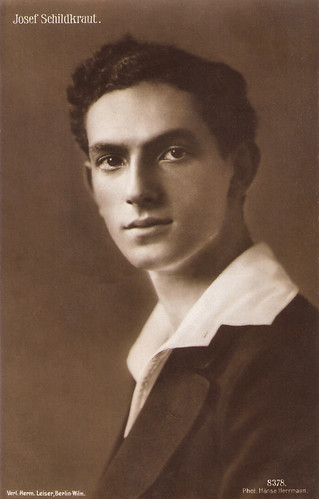
German postcard by Verlag Hermann Leiser, Berlin-Wilm., no. 8378. Photo: Hänse Herrmann.
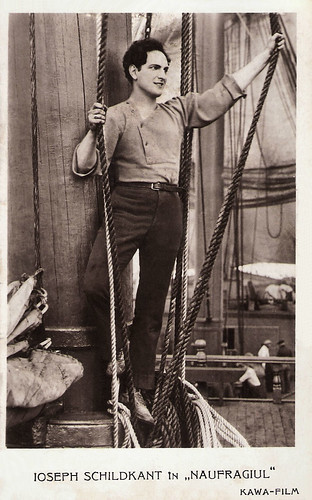
Romanian postcard by Kawa Film. Photo: Joseph Schildkraut in Shipwrecked (Joseph Henabery, 1926).
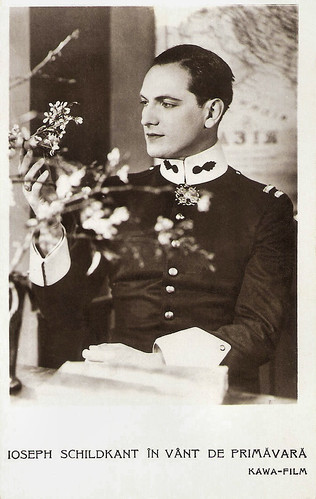
Romanian postcard. Photo: Kawa-Film. Joseph Schildkraut in Young April (Donald Crisp, 1926).
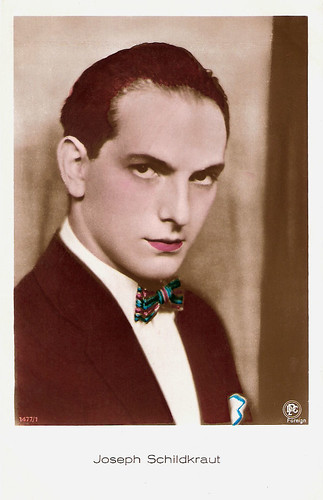
German postcard by Ross Verlag Foreign, no. 1477/1, 1927-1928. Photo: DPG (Deutsche Photographische Gesellschaft).
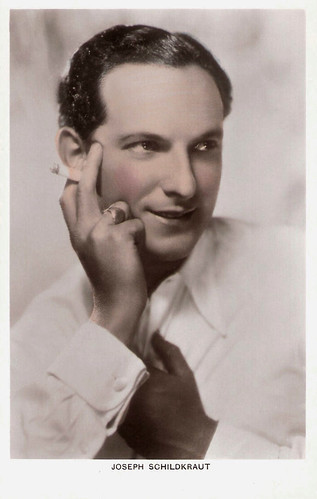
British postcard in the Colourgraph Series, London, no. C 92.
His marriage-threatening, Lothario-like behaviour off-stage
Joseph Schildkraut was born in Vienna, Austria-Hungary (now Austria), in 1896. He was the son of Erna (née Weinstein) and famed Yiddish stage actor Rudolph Schildkraut.
The family moved to Hamburg, Germany, when Joseph was 4. Joseph studied the piano and violin and grew inspired with his father's profession. On stage (with his father) from age 6, the family again relocated to Berlin where his father built a strong association with famed theatrical director Max Reinhardt.
Following Joseph's graduation from Berlin's Royal Academy of Music in 1911, the family migrated to America and settled in New York in 1912. His father continued making his mark in America's Yiddish theatre while Joseph was accepted into the American Academy of Dramatic Arts.
Gary Brumburgh at IMDb : "Offered lucrative theatre work back in Germany, Rudolf and family returned to Europe where Joseph began to grow in stature on the stage with the help of mentor Albert Bassermann . Joseph, like his father, would become well known not only for his prodigious talents on stage, but his marriage-threatening, Lothario-like behaviour off-stage."
Joseph made his stage debut in 1913, in Berlin, and started his film career in 1915 in the German feature films Dämon und Mensch/Demon and human (Richard Oswald, 1915) and Schlemihl (Richard Oswald, 1915) in which his father played the leading role. Roles followed in the films Das Wiegenlied/The Lullaby (Max Mack, 1916) with Aud Egede-Nissen and Leopoldine Konstantin , and Der Glücksschneider (Hans Otto, 1916) opposite his father.
In 1920 he appeared in the Austrian films Der Roman der Komtesse Orth/The Novel of Countess Ruth (Hans Otto, 1920) and Theodor Herzl, der Bannerträger des jüdischen Volkes/Theodor Herzl, the standard bearer of the Jewish people (Otto Kreisler, 1921), an early film biography of the founder of modern Zionism.
Then the family Schildkraut emigrated to the USA. From 1920, Joseph appeared in Broadway productions. Among the plays that he starred in was a notable production of 'Peer Gynt'. In 1921, Schildkraut played the title role in the first American stage production of Ferenc Molnár's 'Liliom', the play that would eventually become the basis for Rodgers and Hammerstein's 'Carousel'.
He then began working in silent films, although he did return to the stage occasionally. He had immediate success as the Chevalier de Vaudrey in D. W. Griffith's classic Orphans of the Storm (1921) alongside sisters Lillian Gish and Dorothy Gish. It made him a matinee idol along the lines of Rudolph Valentino and Ramon Navarro .
Later, he was featured in Cecil B. DeMille's epics The Road to Yesterday (1925) and The King of Kings (1927), as Judas Iscariot. Schildkraut's father Rudolf also appeared in the film as the high priest Caiaphas.
Joseph Schildkraut also played a Viennese-accented, non-singing Gaylord Ravenal in the part-talkie film version of Edna Ferber's Show Boat (1929) opposite Laura La Plante as Magnolia. The character of Gaylord as written in the 1929 film was much closer to Ferber's original than to the depiction of him in the classic Kern and Hammerstein musical play based on the novel as well as the 1936 and 1951 film versions of the musical, but the 1929 film was not a critical or box-office success.
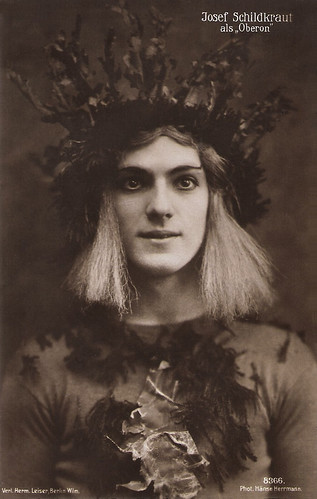
German postcard by Verlag Hermann Leiser, Berlin-Wilm., no. 8366. Photo: Hänse Herrmann. Joseph Schildkraut as Oberon in a German stage production of A Midsummer Night's Dream.
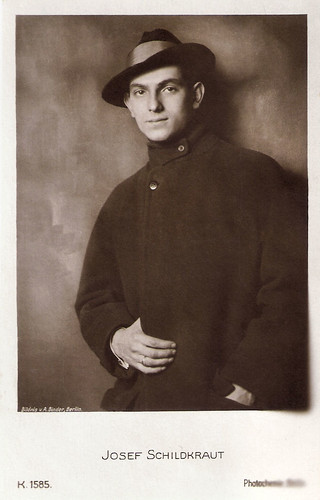
German postcard by Photochemie, Berlin, no. K. 1585. Photo: Alex Binder.
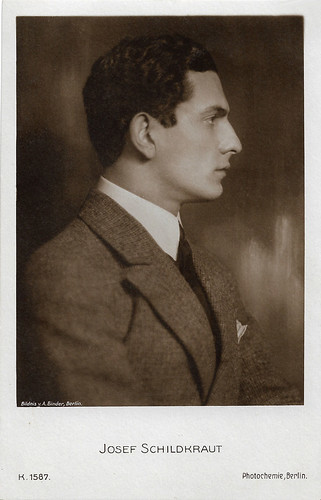
German postcard by Photochemie, Berlin, no. K. 1587. Photo: Alex Binder.
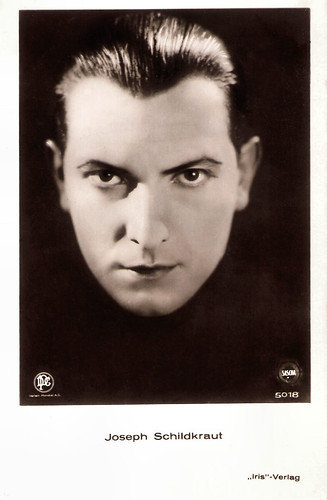
Austrian postcard by Iris Verlag, no. 5018. Photo: DPG (Deutsche Photographische Gesellschaft) / Sascha Film.
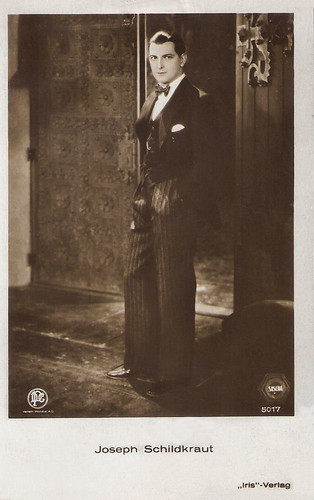
Austrian postcard by Iris-Verlag, no. 5027. Photo: DPG (Deutsche Photographische Gesellschaft) / Sascha.
The Father of Anne Frank
Joseph Schildkraut's career peaked in the 1930s. Despite his preference for the theatre, Depression-era finances forced him to relocate to Los Angeles for more job security. He played Wallace Beery's nemesis, General Pascal in Viva Villa! (Jack Conway, 1934). In 1934 he also played King Herod alongside Claudette Colbert in Cleopatra (Cecil B. DeMille, 1934).
He received an Academy Award for Best Supporting Actor for his role as Alfred Dreyfus in The Life of Emile Zola (William Dieterle, 1937), in which he acted alongside Paul Muni and Gale Sondergaard. He gained further fame for playing the ambitious duc d'Orléans in the historical epic Marie Antoinette (WS Van Dyke, 1938), opposite Norma Shearer and Tyrone Power , and gave a notable performance as the villainous Nicolas Fouquet in the adventure film The Man in the Iron Mask (James Whale, 1939), featuring Louis Hayward.
His film output slowed down considerably at the outbreak of WWII in 1941. He continued to show vitality on the stage with notable successes in 'Clash by Night' (1941) with Tallulah Bankhead, 'Uncle Harry' (1942) and 'The Cherry Orchard' (1944) with Eva Le Gallienne.
Schildkraut is perhaps best remembered today for playing the role of Otto Frank, the Jewish father-in-hiding, in both the original stage production (in 1955) and film version of The Diary of Anne Frank (George Stevens, 1959), starring Millie Perkins.
His biography 'My Father and I' was published in 1959. Joseph Schildkraut was also an active character actor and appeared in guest roles on several early television shows, including the Hallmark Hall of Fame, in which he played Claudius in the 1953 television production of Hamlet, with Maurice Evans in the title role. Schildkraut also hosted and starred in Joseph Schildkraut Presents, a short-lived series on the DuMont Television Network from October 1953 to January 1954.
In 1961, during the 3rd season of The Twilight Zone, he made his first appearance on episode 9, 'Deaths-Head Revisited'. He later played an elderly man in 'The Trade-Ins' in season 3, episode 31 of the same show. In 1963, he was nominated for a Best Actor Emmy Award for his performance in a guest starring role on NBC's Sam Benedict legal drama which starred Edmond O'Brien and Richard Rust.
Schildkraut was married three times. His first marriage was to actress Elise Bartlett in 1923; they divorced in 1931. He married Mary McKay in 1932, until her death in 1962. In 1963, Schildkraut married Leonora Rogers, who survived him. In 1964, Schildkraut died at his home in New York City of a heart attack after a song-and-dance rehearsal for a musical comedy 'Cafe Crown,' which was due for a New York opening in the spring of 1964. He was 67. His father also died at the same age, also of a heart attack.
His last film role was Nicodemus in the epic failure The Greatest Story Ever Told (George Stevens, 1965). The film was released posthumously. For his contributions to the motion picture industry, Schildkraut has a star on the Hollywood Walk of Fame at 6780 Hollywood Boulevard. He is interred in the Hollywood Forever Cemetery.
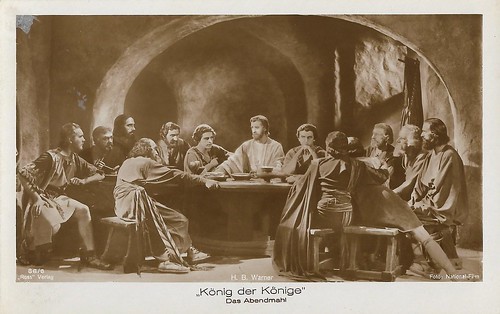
German postcard by Ross Verlag, no. 86/8. Photo: National Film. H.B. Warner as Jesus and at his right Joseph Schildkraut as Judas in The King of Kings (Cecil B. deMille, 1927). Caption: The Last Supper.
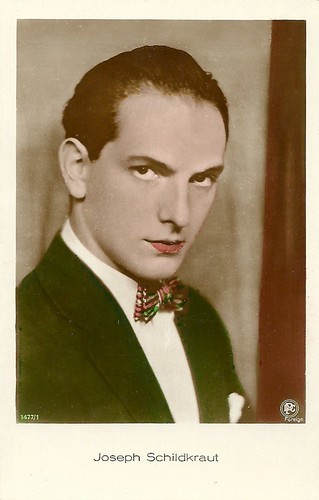
German postcard by Ross Verlag Foreign, no. 1477/1. Photo: DPG (Deutsche Photographische Gesellschaft).
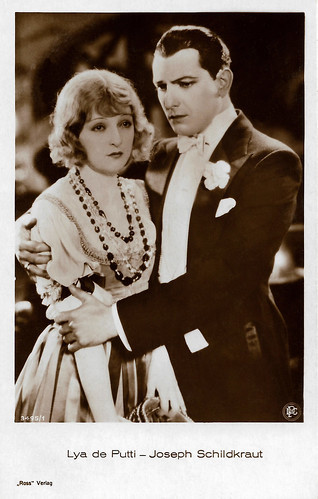
German postcard by Ross Verlag, no. 3495/1, 1928-1929. Photo: DPG (Deutsche Photographische Gesellschaft). Lya de Putti and Joseph Schildkraut in The Heart Thief (Nils Olaf Chrisander, 1927).
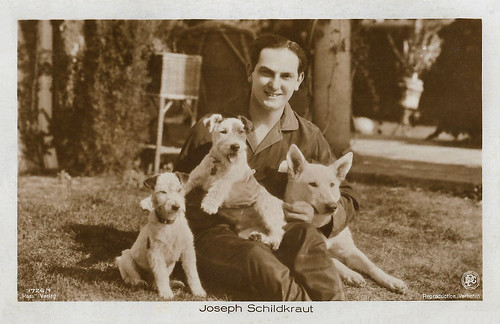
German postcard by Ross Verlag, no. 3726/1, 1928-1929. Photo: DPG (Deutsche Photographische Gesellschaft).
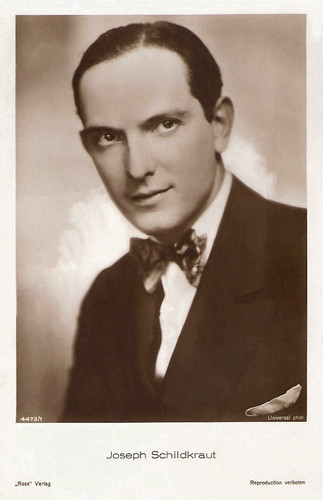
German postcard by Ross Verlag, no. 4473/1, 1929-1930. Photo: Universal.
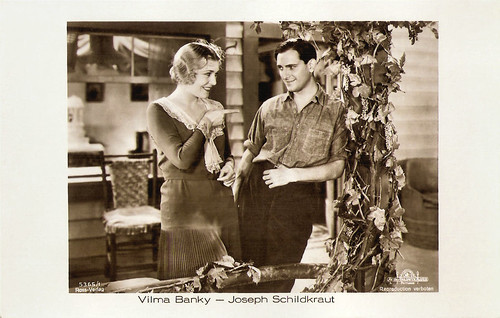
German postcard by Ross Verlag, no. 5365/1, 1930-1931. Photo: Metro-Goldwyn-Mayer (MGM). Vilma Banky and Joseph Schildkraut in A Lady to Love ( Victor Sjöström, 1930).
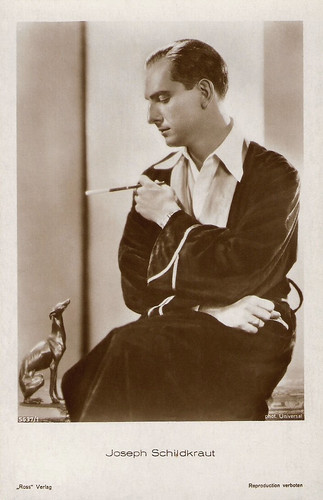
German postcard by Ross Verlag, no. 5637/1, 1930-1931. Photo: Universal.
Sources: (IMDb), Wikipedia (English, Dutch and German) and .

German postcard by Verlag Hermann Leiser, Berlin-Wilm., no. 8378. Photo: Hänse Herrmann.

Romanian postcard by Kawa Film. Photo: Joseph Schildkraut in Shipwrecked (Joseph Henabery, 1926).

Romanian postcard. Photo: Kawa-Film. Joseph Schildkraut in Young April (Donald Crisp, 1926).

German postcard by Ross Verlag Foreign, no. 1477/1, 1927-1928. Photo: DPG (Deutsche Photographische Gesellschaft).

British postcard in the Colourgraph Series, London, no. C 92.
His marriage-threatening, Lothario-like behaviour off-stage
Joseph Schildkraut was born in Vienna, Austria-Hungary (now Austria), in 1896. He was the son of Erna (née Weinstein) and famed Yiddish stage actor Rudolph Schildkraut.
The family moved to Hamburg, Germany, when Joseph was 4. Joseph studied the piano and violin and grew inspired with his father's profession. On stage (with his father) from age 6, the family again relocated to Berlin where his father built a strong association with famed theatrical director Max Reinhardt.
Following Joseph's graduation from Berlin's Royal Academy of Music in 1911, the family migrated to America and settled in New York in 1912. His father continued making his mark in America's Yiddish theatre while Joseph was accepted into the American Academy of Dramatic Arts.
Gary Brumburgh at IMDb : "Offered lucrative theatre work back in Germany, Rudolf and family returned to Europe where Joseph began to grow in stature on the stage with the help of mentor Albert Bassermann . Joseph, like his father, would become well known not only for his prodigious talents on stage, but his marriage-threatening, Lothario-like behaviour off-stage."
Joseph made his stage debut in 1913, in Berlin, and started his film career in 1915 in the German feature films Dämon und Mensch/Demon and human (Richard Oswald, 1915) and Schlemihl (Richard Oswald, 1915) in which his father played the leading role. Roles followed in the films Das Wiegenlied/The Lullaby (Max Mack, 1916) with Aud Egede-Nissen and Leopoldine Konstantin , and Der Glücksschneider (Hans Otto, 1916) opposite his father.
In 1920 he appeared in the Austrian films Der Roman der Komtesse Orth/The Novel of Countess Ruth (Hans Otto, 1920) and Theodor Herzl, der Bannerträger des jüdischen Volkes/Theodor Herzl, the standard bearer of the Jewish people (Otto Kreisler, 1921), an early film biography of the founder of modern Zionism.
Then the family Schildkraut emigrated to the USA. From 1920, Joseph appeared in Broadway productions. Among the plays that he starred in was a notable production of 'Peer Gynt'. In 1921, Schildkraut played the title role in the first American stage production of Ferenc Molnár's 'Liliom', the play that would eventually become the basis for Rodgers and Hammerstein's 'Carousel'.
He then began working in silent films, although he did return to the stage occasionally. He had immediate success as the Chevalier de Vaudrey in D. W. Griffith's classic Orphans of the Storm (1921) alongside sisters Lillian Gish and Dorothy Gish. It made him a matinee idol along the lines of Rudolph Valentino and Ramon Navarro .
Later, he was featured in Cecil B. DeMille's epics The Road to Yesterday (1925) and The King of Kings (1927), as Judas Iscariot. Schildkraut's father Rudolf also appeared in the film as the high priest Caiaphas.
Joseph Schildkraut also played a Viennese-accented, non-singing Gaylord Ravenal in the part-talkie film version of Edna Ferber's Show Boat (1929) opposite Laura La Plante as Magnolia. The character of Gaylord as written in the 1929 film was much closer to Ferber's original than to the depiction of him in the classic Kern and Hammerstein musical play based on the novel as well as the 1936 and 1951 film versions of the musical, but the 1929 film was not a critical or box-office success.

German postcard by Verlag Hermann Leiser, Berlin-Wilm., no. 8366. Photo: Hänse Herrmann. Joseph Schildkraut as Oberon in a German stage production of A Midsummer Night's Dream.

German postcard by Photochemie, Berlin, no. K. 1585. Photo: Alex Binder.

German postcard by Photochemie, Berlin, no. K. 1587. Photo: Alex Binder.

Austrian postcard by Iris Verlag, no. 5018. Photo: DPG (Deutsche Photographische Gesellschaft) / Sascha Film.

Austrian postcard by Iris-Verlag, no. 5027. Photo: DPG (Deutsche Photographische Gesellschaft) / Sascha.
The Father of Anne Frank
Joseph Schildkraut's career peaked in the 1930s. Despite his preference for the theatre, Depression-era finances forced him to relocate to Los Angeles for more job security. He played Wallace Beery's nemesis, General Pascal in Viva Villa! (Jack Conway, 1934). In 1934 he also played King Herod alongside Claudette Colbert in Cleopatra (Cecil B. DeMille, 1934).
He received an Academy Award for Best Supporting Actor for his role as Alfred Dreyfus in The Life of Emile Zola (William Dieterle, 1937), in which he acted alongside Paul Muni and Gale Sondergaard. He gained further fame for playing the ambitious duc d'Orléans in the historical epic Marie Antoinette (WS Van Dyke, 1938), opposite Norma Shearer and Tyrone Power , and gave a notable performance as the villainous Nicolas Fouquet in the adventure film The Man in the Iron Mask (James Whale, 1939), featuring Louis Hayward.
His film output slowed down considerably at the outbreak of WWII in 1941. He continued to show vitality on the stage with notable successes in 'Clash by Night' (1941) with Tallulah Bankhead, 'Uncle Harry' (1942) and 'The Cherry Orchard' (1944) with Eva Le Gallienne.
Schildkraut is perhaps best remembered today for playing the role of Otto Frank, the Jewish father-in-hiding, in both the original stage production (in 1955) and film version of The Diary of Anne Frank (George Stevens, 1959), starring Millie Perkins.
His biography 'My Father and I' was published in 1959. Joseph Schildkraut was also an active character actor and appeared in guest roles on several early television shows, including the Hallmark Hall of Fame, in which he played Claudius in the 1953 television production of Hamlet, with Maurice Evans in the title role. Schildkraut also hosted and starred in Joseph Schildkraut Presents, a short-lived series on the DuMont Television Network from October 1953 to January 1954.
In 1961, during the 3rd season of The Twilight Zone, he made his first appearance on episode 9, 'Deaths-Head Revisited'. He later played an elderly man in 'The Trade-Ins' in season 3, episode 31 of the same show. In 1963, he was nominated for a Best Actor Emmy Award for his performance in a guest starring role on NBC's Sam Benedict legal drama which starred Edmond O'Brien and Richard Rust.
Schildkraut was married three times. His first marriage was to actress Elise Bartlett in 1923; they divorced in 1931. He married Mary McKay in 1932, until her death in 1962. In 1963, Schildkraut married Leonora Rogers, who survived him. In 1964, Schildkraut died at his home in New York City of a heart attack after a song-and-dance rehearsal for a musical comedy 'Cafe Crown,' which was due for a New York opening in the spring of 1964. He was 67. His father also died at the same age, also of a heart attack.
His last film role was Nicodemus in the epic failure The Greatest Story Ever Told (George Stevens, 1965). The film was released posthumously. For his contributions to the motion picture industry, Schildkraut has a star on the Hollywood Walk of Fame at 6780 Hollywood Boulevard. He is interred in the Hollywood Forever Cemetery.

German postcard by Ross Verlag, no. 86/8. Photo: National Film. H.B. Warner as Jesus and at his right Joseph Schildkraut as Judas in The King of Kings (Cecil B. deMille, 1927). Caption: The Last Supper.

German postcard by Ross Verlag Foreign, no. 1477/1. Photo: DPG (Deutsche Photographische Gesellschaft).

German postcard by Ross Verlag, no. 3495/1, 1928-1929. Photo: DPG (Deutsche Photographische Gesellschaft). Lya de Putti and Joseph Schildkraut in The Heart Thief (Nils Olaf Chrisander, 1927).

German postcard by Ross Verlag, no. 3726/1, 1928-1929. Photo: DPG (Deutsche Photographische Gesellschaft).

German postcard by Ross Verlag, no. 4473/1, 1929-1930. Photo: Universal.

German postcard by Ross Verlag, no. 5365/1, 1930-1931. Photo: Metro-Goldwyn-Mayer (MGM). Vilma Banky and Joseph Schildkraut in A Lady to Love ( Victor Sjöström, 1930).

German postcard by Ross Verlag, no. 5637/1, 1930-1931. Photo: Universal.
Sources: (IMDb), Wikipedia (English, Dutch and German) and .
Published on January 23, 2020 22:00
January 22, 2020
Margarete Schön
The career of German stage and film actress Margarete Schön (1895-1985) spanned nearly fifty years. She is best known for her role as Kriemhild, the beautiful but revengeful princess of Burgundy in Fritz Lang’s silent epic Die Nibelungen (1924).

German postcard by Verlag Herm. Leiser, Berlin-Wilm., no. 4838. Photo: Atelier E. Bieber, Berlin.

German postcard by Ross Verlag, no. 672/6, 1919-1924. Photo: Decla-Ufa-Film. Publicity still for Die Nibelungen (Fritz Lang, 1924).
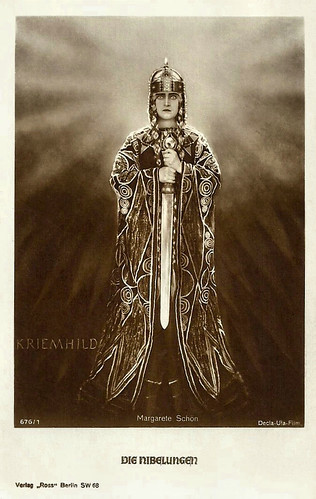
German postcard by Ross Verlag, no. 676/1, 1919-1924. Photo: Decla-Ufa-Film. Publicity still for Die Nibelungen (Fritz Lang, 1924).

German postcard by Ross Verlag, Berlin, no. 677/2. Photo: Decla-Ufa-Film. Publicity still for Die Nibelungen, II. Teil, Kriemhilds Rache/Kriemhild's Revenge (Fritz Lang, 1924). Kriemhild (Margarete Schön) at the spring where Siegfried died.

German postcard by Ross Verlag, no. 700/10. Photo: Ufa. Publicity still for Kampf um die Scholle/Struggle for the Soil (Erich Waschneck, 1925) with Margarete Schön as Frieda, wife of Axel.
The Vengeful Kriemhild
Margarete Schön was born as Margarete Schippang in Magdeburg, Germany in 1895.
She received private acting lessons with the theatre actor Hans Calm in Dessau. In 1912 she made her stage debut in Bad Freienwalde. Shortly thereafter, she received a commitment at the municipal theatre of Bromberg (now Bydgoszcz, Poland). From 1915 to 1918, she was part of the ensemble cast of the Deutsches Theater in Hannover, and from 1918 to 1945 she performed at the famous Staatstheater Berlin (Berlin State Theatre).
According to Wikipedia , Schön made her film debut in the silent Du meine Himmelskönigin/You are my queen of heaven (Carl Wilhelm, 1919). Philippe Pelletier at Ciné Artistes and Thomas Staedeli at Cyranos write that her first appearance was a year earlier, in Schirokko/Scirocco (Edmund Heuberger, 1918) with Kurt Brenkendorf.
She would spend the next years in small roles for directors Carl Froelich, Hanna Henning, and Walter Schmidthässler. She had bigger parts in Die Pflicht zu leben/The obligation to live (Carl Wilhelm, 1919) with Reinhold Schünzel , and Die goldene Krone/The Golden Crown (Alfred Halm, 1920) starring Henny Porten .
She worked several times with the Danish director Robert Dinesen who was her husband at the time. Among their films were Frauen vom Gnadenstein/Women of Gnadenstein (Joe May, Robert Dinesen, 1920), and Der Leidensweg der Inge Krafft/Inge Krafft's Calvary (Robert Dinesen, 1921) featuring Mia May .
Schön had a leading role as Hannele’s ( Margarete Schlegel ) mother in the popular drama Hanneles Himmelfahrt/Hannele's Ascension (Urban Gad, 1922), based on the Traumgedicht (dream poem) by Gerhart Hauptman. For director Friedrich Zelnik she appeared in Erniedrigte und beleidigte (1922) starring Lya Mara .
Then she really became a star after the release of Fritz Lang's two-part mythical fantasy Die Nibelungen (1924). Lang and his wife at the time, Thea von Harbou, had written a script based on the epic poem 'Nibelungenlied' written around AD 1200. Schön had a starring role as the vengeful Kriemhild, opposite Paul Richter as the epic hero Siegfried.
The success of Die Nibelungen (1924) would cement her popularity in Germany and she achieved international recognition as an actress. Strangely, there was not a real follow-up film. She appeared in several unremarkable productions. In the more interesting films, like her husband’s Der Weg durch die Nacht/The Way Through the Night (Robert Dinesen, 1929), she only had a supporting part.

German postcard by Ross Verlag, no. 673/1. Photo: Decla-Ufa-Film. Publicity still for Siegfried (Paul Richter) and Kriemhild (Margarete Schön) in part I. of Die Nibelungen (Fritz Lang, 1924).

German postcard by Ross Verlag, no. 700/8. Photo: Ufa. Publicity still for Kampf um die Scholle/Struggle for the Soil (Erich Waschneck, 1925) with Ferdinand von Alten and Margarete Schön.
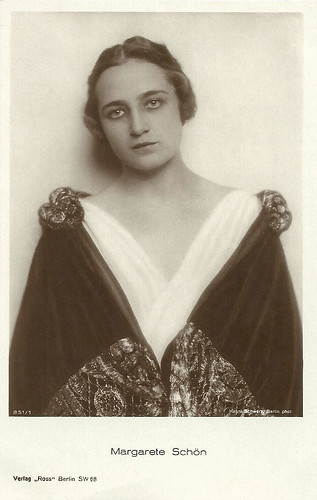
German postcard by Ross Verlag, no. 851/1, 1925-1926. Photo: Hanni Schwarze, Berlin.
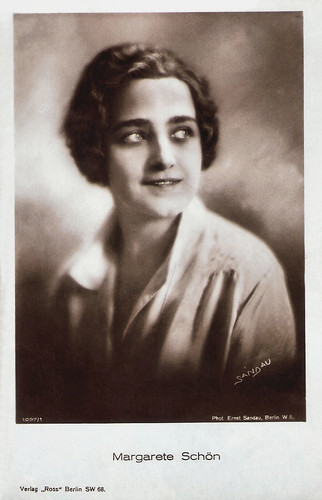
German postcard by Ross Verlag, no. 1097/1, 1927-1928. Photo: Ernst Sandau, Berlin.
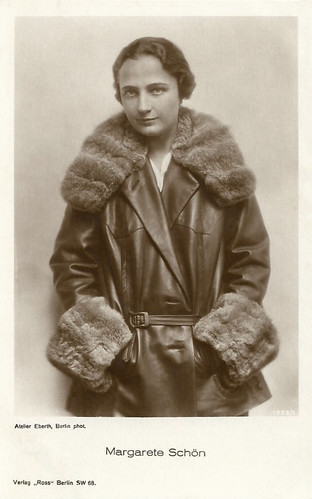
German postcard by Ross Verlag, no. 1922/1, 1927-1928. Photo: Atelier Ebert, Berlin.
Wife or Mother
Margarete Schön made the transition to sound films with ease and through the 1930s and 1940s she was a popular character actress. She often portrayed parts as the wife or the mother.
For the Ufa she played princess Amalie in Das flötenkonzert von Sans-Souci/The Flute Concert of Sans-Souci (Gustav Ucicky, 1930) starring Otto Gebühr as King Frederick II of Prussia; Madame Mercier in the Chopin biography Abschiedswalzer/Farewell Waltz (Géza von Bolváry, 1934), and the mother of Ilse Werner in Ihr erstes Erlebnis/Her First Experience (Joseph von Báky, 1939).
In 1931 she even co-directed a film herself, Schön ist die Manöverzeit/Manoeuver Time Is Fine (Margarete Schön, Erich Schönfelder, 1931) with Ida Wüst . It would remain her only directorial job.
During the Second World War she appeared in approximately ten films, but she generally avoided roles in Nazi propaganda films and stayed decidedly apolitical. One exception was an uncredited bit part in Veit Harlan 's nationalistic film Kolberg (Veit Harlan, 1945) starring Heinrich George .
One of her most popular roles of the era was the character Frau Knauer opposite Heinz Rühmann in the classic comedy Die Feuerzangenbowle/The Punch Bowl (Helmut Weiss, 1944) for the Terra-Filmkunst studios.
After the Second World War, Schön worked extensively for the radio and also worked as a voice actor for the synchronisation of foreign films.
From 1948 to 1950, she played for the Deutsche Film-Aktiengesellschaft (DEFA), the state-owned film studio of East Germany. There she appeared in small roles in such films as Affaire Blum/The Blum Affair (Erich Engel, 1948) about an anti-Semitic court case in Weimar Germany, Die blauen Schwerter/The Blue Swords (Wolfgang Schleif, 1949) starring Hans Quest as the inventor of blue porcelain, and the biography Semmelweis - Retter der Mütter/Dr. Semmelweis (Georg C. Klaren, 1950) with Käthe Braun.
In West-Germany she had parts in such films as the thriller Rittmeister Wronski/Cavalry Captain Wronski (Ulrich Erfurth, 1954) starring Willi Birgel , and Oberwachtmeister Borck/Sergeant Borck (Gerhard Lamprecht, 1955). Her last screen appearance was in the TV film Ich rufe Dresden/I Call Dresden (Curt Goetz-Pflug, 1960).
That same year Margarete Schön retired from acting. In 1968, she was awarded the Bundesfilmpreis for her long and outstanding achievements in the German cinema. At the age of 90, she died in West-Berlin, Germany in 1985. Schön was married to Danish director Robert Dinesen .

German postcard by Ross Verlag, Berlin, no. 673/4, 1919-1924. Photo: Decla-Ufa-Film. Publicity still for Die Nibelungen: Siegfried (Fritz Lang, 1924). Caption: Siegfried ( Paul Richter ) presents Kriemhild (Margarete Schön) the circlet.

German postcard by Ross Verlag, Berlin, nr. 673/6, ca. 1924. Photo: Decla-Ufa-Film. Publicity still for Die Nibelungen: Siegfried (Fritz Lang, 1924). Kriemhild (Margarete Schön) mourns Siegfried's ( Paul Richter ) death and points accusingly to Volker von Alzey ( Hans Adalbert Schlettow ).

German postcard by Ross Verlag, Berlin, no. 675/5. Photo: Decla-Ufa-Film. Publicity still for Die Nibelungen, part I, Siegfried (Fritz Lang, 1924). Kriemhild (Margarete Schön) and the women in the 'kemenate', the heated private room of the castle, also called 'cabinet'.
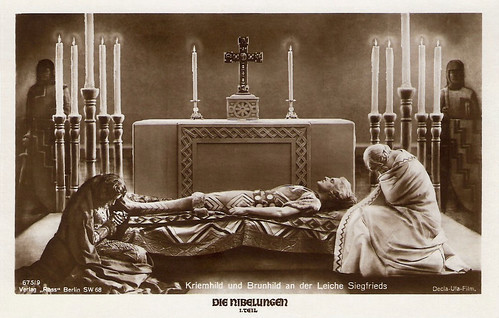
German postcard by Ross Verlag, Berlin, no. 675/9, 1919-1924. Photo: Decla-Ufa-Film. Publicity still for Die Nibelungen: Siegfried (Fritz Lang, 1924). Kriemhild (Margarete Schön) and Brunhild ( Hanna Ralph ) at the side of the body of Siegfried ( Paul Richter ).
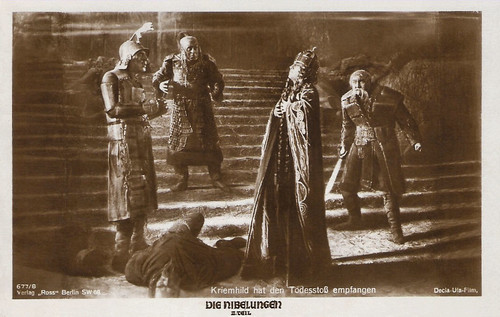
German postcard by Ross Verlag, Berlin, no. 677/8, 1919-1924. Photo: Decla-Ufa-Film. Publicity still for Die Nibelungen 2: Kriemhilds Rache/Die Nibelungen: Kriemhild's Revenge (Fritz Lang, 1924). Kriemhild (Margarete Schön) has got the deathblow. In the back, King Hetzel ( Rudolf Klein-Rogge ) looks on in astonishment.
Sources: Philippe Pelletier (CinéArtistes - French), Volker Wachter (DEFA Filmsterne - German), Thomas Staedeli (Cyranos), Wikipedia and .

German postcard by Verlag Herm. Leiser, Berlin-Wilm., no. 4838. Photo: Atelier E. Bieber, Berlin.

German postcard by Ross Verlag, no. 672/6, 1919-1924. Photo: Decla-Ufa-Film. Publicity still for Die Nibelungen (Fritz Lang, 1924).

German postcard by Ross Verlag, no. 676/1, 1919-1924. Photo: Decla-Ufa-Film. Publicity still for Die Nibelungen (Fritz Lang, 1924).

German postcard by Ross Verlag, Berlin, no. 677/2. Photo: Decla-Ufa-Film. Publicity still for Die Nibelungen, II. Teil, Kriemhilds Rache/Kriemhild's Revenge (Fritz Lang, 1924). Kriemhild (Margarete Schön) at the spring where Siegfried died.

German postcard by Ross Verlag, no. 700/10. Photo: Ufa. Publicity still for Kampf um die Scholle/Struggle for the Soil (Erich Waschneck, 1925) with Margarete Schön as Frieda, wife of Axel.
The Vengeful Kriemhild
Margarete Schön was born as Margarete Schippang in Magdeburg, Germany in 1895.
She received private acting lessons with the theatre actor Hans Calm in Dessau. In 1912 she made her stage debut in Bad Freienwalde. Shortly thereafter, she received a commitment at the municipal theatre of Bromberg (now Bydgoszcz, Poland). From 1915 to 1918, she was part of the ensemble cast of the Deutsches Theater in Hannover, and from 1918 to 1945 she performed at the famous Staatstheater Berlin (Berlin State Theatre).
According to Wikipedia , Schön made her film debut in the silent Du meine Himmelskönigin/You are my queen of heaven (Carl Wilhelm, 1919). Philippe Pelletier at Ciné Artistes and Thomas Staedeli at Cyranos write that her first appearance was a year earlier, in Schirokko/Scirocco (Edmund Heuberger, 1918) with Kurt Brenkendorf.
She would spend the next years in small roles for directors Carl Froelich, Hanna Henning, and Walter Schmidthässler. She had bigger parts in Die Pflicht zu leben/The obligation to live (Carl Wilhelm, 1919) with Reinhold Schünzel , and Die goldene Krone/The Golden Crown (Alfred Halm, 1920) starring Henny Porten .
She worked several times with the Danish director Robert Dinesen who was her husband at the time. Among their films were Frauen vom Gnadenstein/Women of Gnadenstein (Joe May, Robert Dinesen, 1920), and Der Leidensweg der Inge Krafft/Inge Krafft's Calvary (Robert Dinesen, 1921) featuring Mia May .
Schön had a leading role as Hannele’s ( Margarete Schlegel ) mother in the popular drama Hanneles Himmelfahrt/Hannele's Ascension (Urban Gad, 1922), based on the Traumgedicht (dream poem) by Gerhart Hauptman. For director Friedrich Zelnik she appeared in Erniedrigte und beleidigte (1922) starring Lya Mara .
Then she really became a star after the release of Fritz Lang's two-part mythical fantasy Die Nibelungen (1924). Lang and his wife at the time, Thea von Harbou, had written a script based on the epic poem 'Nibelungenlied' written around AD 1200. Schön had a starring role as the vengeful Kriemhild, opposite Paul Richter as the epic hero Siegfried.
The success of Die Nibelungen (1924) would cement her popularity in Germany and she achieved international recognition as an actress. Strangely, there was not a real follow-up film. She appeared in several unremarkable productions. In the more interesting films, like her husband’s Der Weg durch die Nacht/The Way Through the Night (Robert Dinesen, 1929), she only had a supporting part.

German postcard by Ross Verlag, no. 673/1. Photo: Decla-Ufa-Film. Publicity still for Siegfried (Paul Richter) and Kriemhild (Margarete Schön) in part I. of Die Nibelungen (Fritz Lang, 1924).

German postcard by Ross Verlag, no. 700/8. Photo: Ufa. Publicity still for Kampf um die Scholle/Struggle for the Soil (Erich Waschneck, 1925) with Ferdinand von Alten and Margarete Schön.

German postcard by Ross Verlag, no. 851/1, 1925-1926. Photo: Hanni Schwarze, Berlin.

German postcard by Ross Verlag, no. 1097/1, 1927-1928. Photo: Ernst Sandau, Berlin.

German postcard by Ross Verlag, no. 1922/1, 1927-1928. Photo: Atelier Ebert, Berlin.
Wife or Mother
Margarete Schön made the transition to sound films with ease and through the 1930s and 1940s she was a popular character actress. She often portrayed parts as the wife or the mother.
For the Ufa she played princess Amalie in Das flötenkonzert von Sans-Souci/The Flute Concert of Sans-Souci (Gustav Ucicky, 1930) starring Otto Gebühr as King Frederick II of Prussia; Madame Mercier in the Chopin biography Abschiedswalzer/Farewell Waltz (Géza von Bolváry, 1934), and the mother of Ilse Werner in Ihr erstes Erlebnis/Her First Experience (Joseph von Báky, 1939).
In 1931 she even co-directed a film herself, Schön ist die Manöverzeit/Manoeuver Time Is Fine (Margarete Schön, Erich Schönfelder, 1931) with Ida Wüst . It would remain her only directorial job.
During the Second World War she appeared in approximately ten films, but she generally avoided roles in Nazi propaganda films and stayed decidedly apolitical. One exception was an uncredited bit part in Veit Harlan 's nationalistic film Kolberg (Veit Harlan, 1945) starring Heinrich George .
One of her most popular roles of the era was the character Frau Knauer opposite Heinz Rühmann in the classic comedy Die Feuerzangenbowle/The Punch Bowl (Helmut Weiss, 1944) for the Terra-Filmkunst studios.
After the Second World War, Schön worked extensively for the radio and also worked as a voice actor for the synchronisation of foreign films.
From 1948 to 1950, she played for the Deutsche Film-Aktiengesellschaft (DEFA), the state-owned film studio of East Germany. There she appeared in small roles in such films as Affaire Blum/The Blum Affair (Erich Engel, 1948) about an anti-Semitic court case in Weimar Germany, Die blauen Schwerter/The Blue Swords (Wolfgang Schleif, 1949) starring Hans Quest as the inventor of blue porcelain, and the biography Semmelweis - Retter der Mütter/Dr. Semmelweis (Georg C. Klaren, 1950) with Käthe Braun.
In West-Germany she had parts in such films as the thriller Rittmeister Wronski/Cavalry Captain Wronski (Ulrich Erfurth, 1954) starring Willi Birgel , and Oberwachtmeister Borck/Sergeant Borck (Gerhard Lamprecht, 1955). Her last screen appearance was in the TV film Ich rufe Dresden/I Call Dresden (Curt Goetz-Pflug, 1960).
That same year Margarete Schön retired from acting. In 1968, she was awarded the Bundesfilmpreis for her long and outstanding achievements in the German cinema. At the age of 90, she died in West-Berlin, Germany in 1985. Schön was married to Danish director Robert Dinesen .

German postcard by Ross Verlag, Berlin, no. 673/4, 1919-1924. Photo: Decla-Ufa-Film. Publicity still for Die Nibelungen: Siegfried (Fritz Lang, 1924). Caption: Siegfried ( Paul Richter ) presents Kriemhild (Margarete Schön) the circlet.

German postcard by Ross Verlag, Berlin, nr. 673/6, ca. 1924. Photo: Decla-Ufa-Film. Publicity still for Die Nibelungen: Siegfried (Fritz Lang, 1924). Kriemhild (Margarete Schön) mourns Siegfried's ( Paul Richter ) death and points accusingly to Volker von Alzey ( Hans Adalbert Schlettow ).

German postcard by Ross Verlag, Berlin, no. 675/5. Photo: Decla-Ufa-Film. Publicity still for Die Nibelungen, part I, Siegfried (Fritz Lang, 1924). Kriemhild (Margarete Schön) and the women in the 'kemenate', the heated private room of the castle, also called 'cabinet'.

German postcard by Ross Verlag, Berlin, no. 675/9, 1919-1924. Photo: Decla-Ufa-Film. Publicity still for Die Nibelungen: Siegfried (Fritz Lang, 1924). Kriemhild (Margarete Schön) and Brunhild ( Hanna Ralph ) at the side of the body of Siegfried ( Paul Richter ).

German postcard by Ross Verlag, Berlin, no. 677/8, 1919-1924. Photo: Decla-Ufa-Film. Publicity still for Die Nibelungen 2: Kriemhilds Rache/Die Nibelungen: Kriemhild's Revenge (Fritz Lang, 1924). Kriemhild (Margarete Schön) has got the deathblow. In the back, King Hetzel ( Rudolf Klein-Rogge ) looks on in astonishment.
Sources: Philippe Pelletier (CinéArtistes - French), Volker Wachter (DEFA Filmsterne - German), Thomas Staedeli (Cyranos), Wikipedia and .
Published on January 22, 2020 22:00
January 21, 2020
Klári Tolnay
Klári Tolnay (1914-1998) was one of Hungary's most popular film and theatre stars. In the 1930s she was the glamorous star of many sophisticated comedies. Tolnay received the prestigious Kossuth Prize of her country in 1951 and 1952.
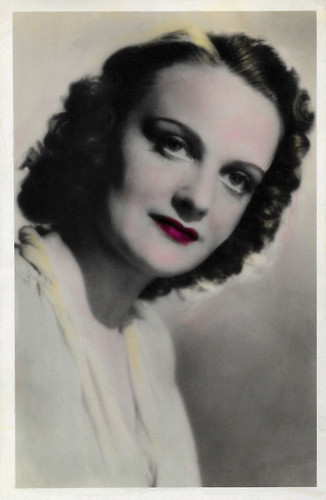
Hungarian postcard by Filmbolt, no. 111. Photo: Havasi Napsütes / Objectiv Film.
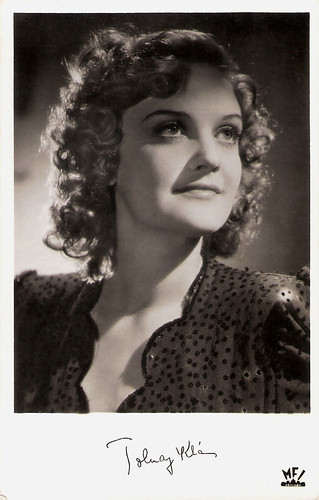
Hungarian postcard by Képzõmuvészeti Alap Kiadóvállata, Budapest, no. F. 410/563. Photo: MFI.
A virginal tease
Klári Tolnay was born Rozália Klára Tolnay (in Hungarian: Tolnay Rozália Klára) in 1914 in Budapest, then capital of the Kingdom of Hungary, integrated into the immense Habsburg Empire, now Hungary. She was the daughter of István Tolnay and Eleonóra Siess.
'Klarika' spent her childhood in the small village of Mohora, Nógrád county, on the estate of her father. Finishing elementary school there, she continued secondary school studies in Balassagyarmat, two years at the school operated by Institutum Beatae Mariae Virginis in Nyíregyháza, finishing high school in Debrecen's School of Business.
Singing and playing music since childhood, she followed the advice of newspaper editor János Bókay, and auditioned herself to prominent actors of the time, Gábor Rajnai, Jenő Heltai, and Sándor Hevesi.
After these early attempts were not followed by the desired results, she was spotted and mentored by film maker Béla Gaál, thus starting her career as a film actress at the Hunnia Film Studio. There she appeared in a small part in the comedy Az új rokon/The New Relative (Béla Gaál, 1934) starring Zita Perczel.
Her first notable role was in the romantic comedy Meseautó/The Dream Car (Béla Gaál, 1934) starring Zita Perczel and Ella Gombaszögi. A tycoon falls in love with a poor woman and secretly buys her a car. The film sparked an Eastern European vogue for sophisticated comedies.
Bobb Edwards at Find A Grave : "Tolnay's cover girl looks and breezy style made her a natural for the genre and she went on to star in such titles as Légy jó mindhalálig/Stay Good Until Death (István Székely, 1936), Az én lányom nem olyan/My Daughter Is Different (László Vajda, 1937), and A hölgy egy kissé bogaras/The Lady Is a Little Crazy (Ákos Ráthonyi, 1938), typically as a virginal tease."
In 1934, she was hired by the Vígszínház theatre (the Comedy Theatre of Budapest), to perform smaller roles. In 1936 she married film director Ákos Ráthonyi, and four years later, she gave birth to daughter Zsuzsanna. In 1938, she impressed theatre critics as Juliet in 'Romeo and Juliet', which she performed throughout the nation.
In between she also appeared in the comedy Magdát kicsapják/Magda Expelled (László Vajda, 1938), starring Ida Turay, Tolnay and Antal Páger. The film was based on a play and was remade in Italy as Maddalena, zero in condotta/Maddalena, Zero for Conduct (Vittorio de Sica, 1940) with some changes.
So the young and beautiful actress worked with the greatest directors of her country, some of whom would later have an international career. István Székely was the future Steve Sekely, and László Vajda, became known as Ladislao Vajda. She also worked with Bolváry Géza (later known in Germany as Geza von Bolváry) for Tiszavirág/Flower of the Tisza(1937); and with Tóth Endre, later known in Hollywood as André De Toth, for Toprini nász/Wedding in Toprin (1938) and Hat hét boldogság/Six Weeks of Happiness (1939).
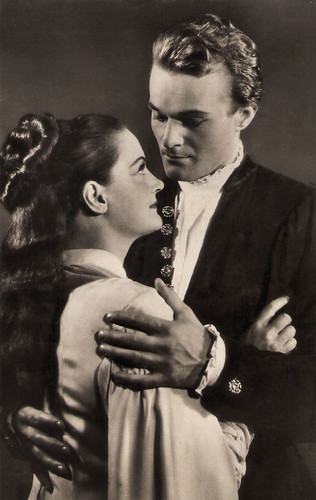
Hungarian postcard by Képzõmuvészeti Alap Kiadóvállata, Budapest, no. F. 410/563. Photo: B. Kálman. Klári Tolnay and Iván Darvas in a stage production of Romeo és Julia (Romeo and Juliet) by William Shakespeare.
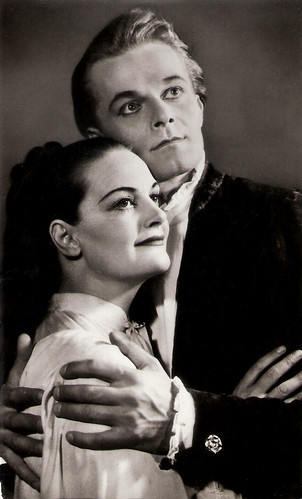
Hungarian postcard by Képzõmuvészeti Alap Kiadóvállata, Budapest, no. F. 410/563. Photo: B. Kálman. Klári Tolnay and Iván Darvas in a stage production of Romeo és Julia (Romeo and Juliet) by William Shakespeare.
Using her star powerIn the early 1940s, Klári Tolnay became a big film star in her country thanks to her performances in a dozen comedies or melodramas directed by her husband Ákos Ráthonyi. These included A szerelem nem szégyen/The Love Is Not Shame (Ákos Ráthonyi, 1940) and Egy csók és más semmi/One kiss and nothing more (Ákos Ráthonyi, 1941), both also with Pál Jávor.
After World War II ended in 1945, Ákos Ráthonyi left Hungary, but Klári Tolnay stayed. She moved away from the film sets. On stage she was still cast in glamorous roles, but as she grew older she greatly broadened her range, particularly in her work with the National and Madach theatres. Leaving the Vígszínház for the Művész Theatre in 1946-1947, Tolnay met Iván Darvas, whom she later married. They divorced in 1958 - according to Wikipedia , but according to IMDb in 1959. After the 1956 revolution, Tolnay's daughter Zsuzsanna followed her father abroad.
In 1947, together with Gyula Benkő and István Somló, Klári Tolnay was appointed as the co-manager of the Vígszínház theatre, where she was a major participant in restoring the institution to its pre-war glory. After the theatre was disbanded by the government in 1950, she joined the Madách Theatre, where she worked until her death in 1998.
Bobb Edwards: "Despite later Communist censorship of the arts, Tolnay was able to use her star power to bring notable American plays to her country. She played Blanche in Tennessee Williams' 'A Streetcar Named Desire', Martha in Edward Albee's 'Who's Afraid of Virginia Woolf?', and Maude in Colin Higgins' 'Harold and Maude', all in their first Hungarian productions."
In 1958, she made a remarkable comeback in the cinema with A tettes ismeretlen/When Cannons Go Away ... (László Ranódy, László Nádasy, 1958), which was released in several other European countries. The film tells the story of young children who find after the war a non-pinned grenade and how the indifference of adults leads to a tragedy.
Tolnay continued to star in films. Her best known later films are the drama Pacsirta/Drama of the Lark (László Ranódy, 1963), which was entered into the 1964 Cannes Film Festival, and Apa/Father (István Szabó, 1966), a coming of age story about a man who copes with his childhood loss of his father against the backdrop of the Hungarian Revolution of 1956 and memories of the Arrow Cross dictatorship.The film, which won several international awards, symbolised the Renaissance of the Hungarian cinema. Zsuzsa Ráthonyi, the daughter of Klári and Ákos Ráthonyi, was also in the cast.
Klári appeared in the Hungarian adventure film A koppányi aga testamentuma/The Testament of Aga Koppanyi (Éva Zsurzs, 1967), the Hungarian-Soviet epic musical/drama Szerelmi álmok – Liszt/Dreams of Love – Liszt (Márton Keleti, 1970) based on the biography of the Hungarian composer and pianist Franz Liszt, and the drama A vörös grófnő/The Red Countess (András Kovács, 1983), which was entered into the 14th Moscow International Film Festival. She also played in several television productions.
Klári Tolnay passed away in 1998 in Budapest, Hungary. She was 84. Overall she appeared in 85 films and 30 plays. Her body rests in the Farkasreti cemetery of the Hungarian capital and a statue of Tolnay now stands in front of the National Theatre in Budapest.
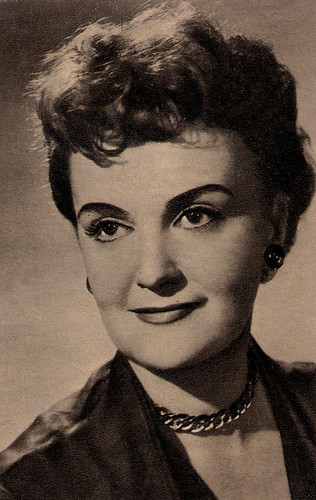
Hungarian postcard by Képzõmuvészeti Alap Kiadóvállata, Budapest, no. 2/582. Photo: Feny.Szöv.
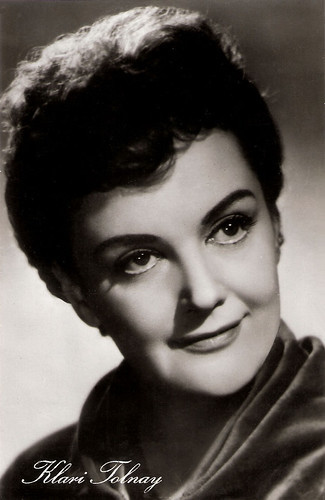
East-German postcard by VEB Progress Film-Vertrieb, Berlin, no. 635, 1958. Photo: Magyar-Film.
Sources: Bobb Edwards (Find A Grave), Philippe Pelletier (CinéArtistes - French), Wikipedia and .

Hungarian postcard by Filmbolt, no. 111. Photo: Havasi Napsütes / Objectiv Film.

Hungarian postcard by Képzõmuvészeti Alap Kiadóvállata, Budapest, no. F. 410/563. Photo: MFI.
A virginal tease
Klári Tolnay was born Rozália Klára Tolnay (in Hungarian: Tolnay Rozália Klára) in 1914 in Budapest, then capital of the Kingdom of Hungary, integrated into the immense Habsburg Empire, now Hungary. She was the daughter of István Tolnay and Eleonóra Siess.
'Klarika' spent her childhood in the small village of Mohora, Nógrád county, on the estate of her father. Finishing elementary school there, she continued secondary school studies in Balassagyarmat, two years at the school operated by Institutum Beatae Mariae Virginis in Nyíregyháza, finishing high school in Debrecen's School of Business.
Singing and playing music since childhood, she followed the advice of newspaper editor János Bókay, and auditioned herself to prominent actors of the time, Gábor Rajnai, Jenő Heltai, and Sándor Hevesi.
After these early attempts were not followed by the desired results, she was spotted and mentored by film maker Béla Gaál, thus starting her career as a film actress at the Hunnia Film Studio. There she appeared in a small part in the comedy Az új rokon/The New Relative (Béla Gaál, 1934) starring Zita Perczel.
Her first notable role was in the romantic comedy Meseautó/The Dream Car (Béla Gaál, 1934) starring Zita Perczel and Ella Gombaszögi. A tycoon falls in love with a poor woman and secretly buys her a car. The film sparked an Eastern European vogue for sophisticated comedies.
Bobb Edwards at Find A Grave : "Tolnay's cover girl looks and breezy style made her a natural for the genre and she went on to star in such titles as Légy jó mindhalálig/Stay Good Until Death (István Székely, 1936), Az én lányom nem olyan/My Daughter Is Different (László Vajda, 1937), and A hölgy egy kissé bogaras/The Lady Is a Little Crazy (Ákos Ráthonyi, 1938), typically as a virginal tease."
In 1934, she was hired by the Vígszínház theatre (the Comedy Theatre of Budapest), to perform smaller roles. In 1936 she married film director Ákos Ráthonyi, and four years later, she gave birth to daughter Zsuzsanna. In 1938, she impressed theatre critics as Juliet in 'Romeo and Juliet', which she performed throughout the nation.
In between she also appeared in the comedy Magdát kicsapják/Magda Expelled (László Vajda, 1938), starring Ida Turay, Tolnay and Antal Páger. The film was based on a play and was remade in Italy as Maddalena, zero in condotta/Maddalena, Zero for Conduct (Vittorio de Sica, 1940) with some changes.
So the young and beautiful actress worked with the greatest directors of her country, some of whom would later have an international career. István Székely was the future Steve Sekely, and László Vajda, became known as Ladislao Vajda. She also worked with Bolváry Géza (later known in Germany as Geza von Bolváry) for Tiszavirág/Flower of the Tisza(1937); and with Tóth Endre, later known in Hollywood as André De Toth, for Toprini nász/Wedding in Toprin (1938) and Hat hét boldogság/Six Weeks of Happiness (1939).

Hungarian postcard by Képzõmuvészeti Alap Kiadóvállata, Budapest, no. F. 410/563. Photo: B. Kálman. Klári Tolnay and Iván Darvas in a stage production of Romeo és Julia (Romeo and Juliet) by William Shakespeare.

Hungarian postcard by Képzõmuvészeti Alap Kiadóvállata, Budapest, no. F. 410/563. Photo: B. Kálman. Klári Tolnay and Iván Darvas in a stage production of Romeo és Julia (Romeo and Juliet) by William Shakespeare.
Using her star powerIn the early 1940s, Klári Tolnay became a big film star in her country thanks to her performances in a dozen comedies or melodramas directed by her husband Ákos Ráthonyi. These included A szerelem nem szégyen/The Love Is Not Shame (Ákos Ráthonyi, 1940) and Egy csók és más semmi/One kiss and nothing more (Ákos Ráthonyi, 1941), both also with Pál Jávor.
After World War II ended in 1945, Ákos Ráthonyi left Hungary, but Klári Tolnay stayed. She moved away from the film sets. On stage she was still cast in glamorous roles, but as she grew older she greatly broadened her range, particularly in her work with the National and Madach theatres. Leaving the Vígszínház for the Művész Theatre in 1946-1947, Tolnay met Iván Darvas, whom she later married. They divorced in 1958 - according to Wikipedia , but according to IMDb in 1959. After the 1956 revolution, Tolnay's daughter Zsuzsanna followed her father abroad.
In 1947, together with Gyula Benkő and István Somló, Klári Tolnay was appointed as the co-manager of the Vígszínház theatre, where she was a major participant in restoring the institution to its pre-war glory. After the theatre was disbanded by the government in 1950, she joined the Madách Theatre, where she worked until her death in 1998.
Bobb Edwards: "Despite later Communist censorship of the arts, Tolnay was able to use her star power to bring notable American plays to her country. She played Blanche in Tennessee Williams' 'A Streetcar Named Desire', Martha in Edward Albee's 'Who's Afraid of Virginia Woolf?', and Maude in Colin Higgins' 'Harold and Maude', all in their first Hungarian productions."
In 1958, she made a remarkable comeback in the cinema with A tettes ismeretlen/When Cannons Go Away ... (László Ranódy, László Nádasy, 1958), which was released in several other European countries. The film tells the story of young children who find after the war a non-pinned grenade and how the indifference of adults leads to a tragedy.
Tolnay continued to star in films. Her best known later films are the drama Pacsirta/Drama of the Lark (László Ranódy, 1963), which was entered into the 1964 Cannes Film Festival, and Apa/Father (István Szabó, 1966), a coming of age story about a man who copes with his childhood loss of his father against the backdrop of the Hungarian Revolution of 1956 and memories of the Arrow Cross dictatorship.The film, which won several international awards, symbolised the Renaissance of the Hungarian cinema. Zsuzsa Ráthonyi, the daughter of Klári and Ákos Ráthonyi, was also in the cast.
Klári appeared in the Hungarian adventure film A koppányi aga testamentuma/The Testament of Aga Koppanyi (Éva Zsurzs, 1967), the Hungarian-Soviet epic musical/drama Szerelmi álmok – Liszt/Dreams of Love – Liszt (Márton Keleti, 1970) based on the biography of the Hungarian composer and pianist Franz Liszt, and the drama A vörös grófnő/The Red Countess (András Kovács, 1983), which was entered into the 14th Moscow International Film Festival. She also played in several television productions.
Klári Tolnay passed away in 1998 in Budapest, Hungary. She was 84. Overall she appeared in 85 films and 30 plays. Her body rests in the Farkasreti cemetery of the Hungarian capital and a statue of Tolnay now stands in front of the National Theatre in Budapest.

Hungarian postcard by Képzõmuvészeti Alap Kiadóvállata, Budapest, no. 2/582. Photo: Feny.Szöv.

East-German postcard by VEB Progress Film-Vertrieb, Berlin, no. 635, 1958. Photo: Magyar-Film.
Sources: Bobb Edwards (Find A Grave), Philippe Pelletier (CinéArtistes - French), Wikipedia and .
Published on January 21, 2020 22:00
January 20, 2020
The Valentine Girl (1917)
American actress Marguerite Clark played the title role in the Famous Players production The Valentine Girl (J. Searle Dawley, 1917). The film was released in Spain as La hija del jugador. Cinematography was by H. Lyman Broening. Distributor was Paramount Pictures. The Valentine Girl, based on a story by Laura Sawyer, is presumed lost, but this series of Amattler postcards is complete.
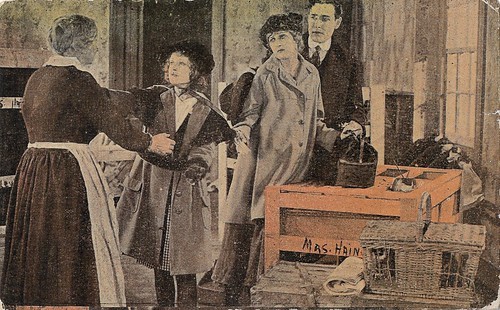
Spanish postcard by Chocolate Amatller, Marca Luna, Series 10, no. 1. Photo: Famous Players / Paramount. Marguerite Clark in The Valentine Girl (J. Searle Dawley, 1917).
[image error]
Spanish postcard by Chocolate Amatller, Marca Luna, Series 10, no. 2. Photo: Famous Players / Paramount. Marguerite Clark in The Valentine Girl (J. Searle Dawley, 1917).
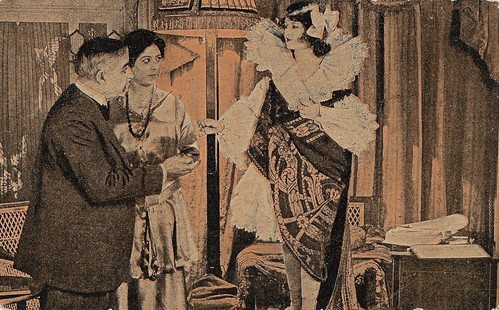
Spanish postcard by Chocolate Amatller, Marca Luna, Series 10, no. 3. Photo: Famous Players / Paramount. Marguerite Clark in The Valentine Girl (J. Searle Dawley, 1917).
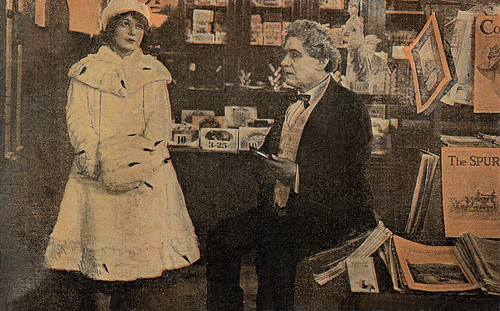
Spanish postcard by Chocolate Amatller, Marca Luna, Series 10, no. 4. Photo: Famous Players / Paramount. Marguerite Clark in The Valentine Girl (J. Searle Dawley, 1917).
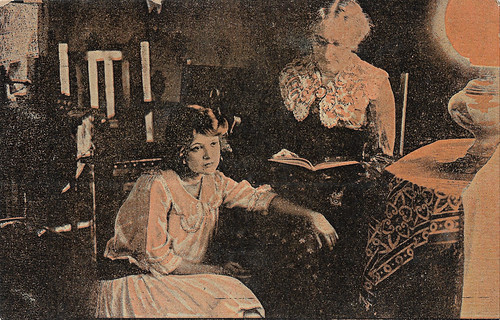
Spanish postcard by Chocolate Amatller, Marca Luna, Series 10, no. 5. Photo: Famous Players / Paramount. Marguerite Clark in The Valentine Girl (J. Searle Dawley, 1917).
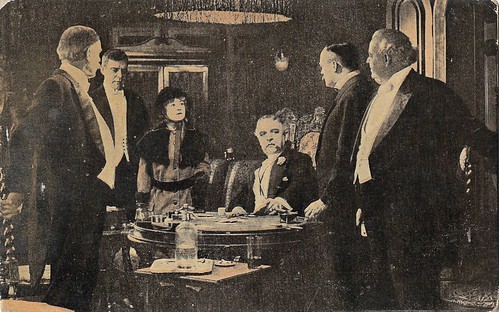
Spanish postcard by Chocolate Amatller, Marca Luna, Series 10, no. 6. Photo: Famous Players / Paramount. Marguerite Clark in The Valentine Girl (J. Searle Dawley, 1917).
All of her charm of impersonation
In The Valentine Girl (J. Searle Dawley, 1917), Marguerite Clark plays Marion Morgan, a motherless young girl. She is given up by her guardian Lucille Haines (Kathryn Adams) to be henceforth raised by her father, John Morgan (Frank Losee), despite his criminal past.
Under the enchanting influence of his daughter, Morgan renounces his life of crime. However, a former partner ( Adolphe Menjou ) frames him for a bank robbery he did not commit, and he is sent to prison.
The distraught Marion runs away and upon taking refuge in a church, she is found and eventually adopted by a kind clergyman family named Bates. As the years pass, Marion grows into a young, beautiful woman who becomes engaged to her childhood friend, now a young man in high society, Robert Wentworth ( Richard Barthelmess ).
When her father is finally released, he seeks to reclaim his daughter. Ashamed, Morgan asks his daughter's forgiveness and explains being sent to prison on false charges. Marion is afraid Robert will back out when he will hear about her identity, but his love his bigger. Once the father's good name is restored, nothing prevents a marriage between Marion and her fiancé anymore.
The Valentine Girl was typical for Clark's child-woman-like characters (she was only 1.50 m.), a type popular in the 1910s (cf. Mary Pickford , Lilian Gish and Mary Miles Minter , who however were blondes while Clark was a brunette).
The Valentine Girl was released in late April 1917. While the Moving Picture World lauded Clark's performance: "She throws into her work all of her charm of impersonation", the Los Angeles Times was unimpressed: "A stock comedy of reminiscent quality."
[image error]
Spanish postcard by Chocolate Amatller, Marca Luna, Series 10, no. 7. Photo: Famous Players / Paramount. Marguerite Clark in The Valentine Girl (J. Searle Dawley, 1917).
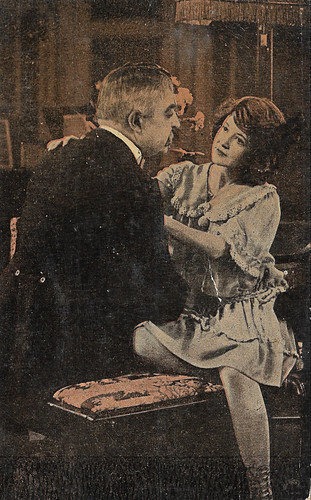
Spanish postcard by Chocolate Amatller, Marca Luna, Series 10, no. 8. Photo: Famous Players / Paramount. Marguerite Clark in The Valentine Girl (J. Searle Dawley, 1917).
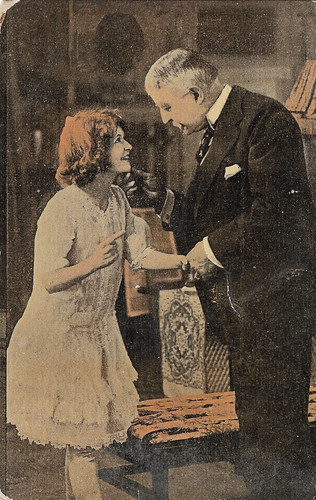
Spanish postcard by Chocolate Amatller, Marca Luna, Series 10, no. 9. Photo: Famous Players / Paramount. Marguerite Clark in The Valentine Girl (J. Searle Dawley, 1917).
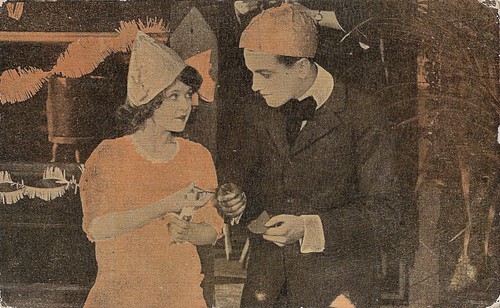
Spanish postcard by Chocolate Amatller, Marca Luna, Series 10, no. 10. Photo: Famous Players / Paramount. Marguerite Clark and Richard Barthelmess in The Valentine Girl (J. Searle Dawley, 1917).
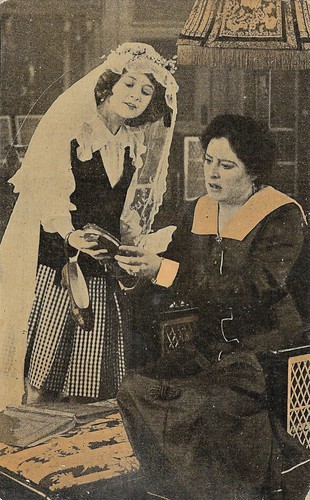
Spanish postcard by Chocolate Amatller, Marca Luna, Series 10, no. 11. Photo: Famous Players / Paramount. Marguerite Clark in The Valentine Girl (J. Searle Dawley, 1917).
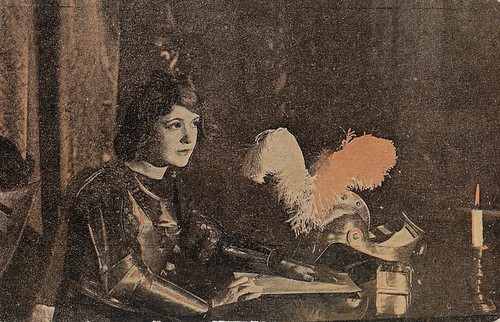
Spanish postcard by Chocolate Amatller, Marca Luna, Series 10, no. 12 (of 12). Photo: Famous Players / Paramount. Marguerite Clark in The Valentine Girl (J. Searle Dawley, 1917).
Source: Curtis Nunn (Marguerite Clark, America's Darling of Broadway and the Silent Screen); Pamela Short (IMDb), and IMDb

Spanish postcard by Chocolate Amatller, Marca Luna, Series 10, no. 1. Photo: Famous Players / Paramount. Marguerite Clark in The Valentine Girl (J. Searle Dawley, 1917).
[image error]
Spanish postcard by Chocolate Amatller, Marca Luna, Series 10, no. 2. Photo: Famous Players / Paramount. Marguerite Clark in The Valentine Girl (J. Searle Dawley, 1917).

Spanish postcard by Chocolate Amatller, Marca Luna, Series 10, no. 3. Photo: Famous Players / Paramount. Marguerite Clark in The Valentine Girl (J. Searle Dawley, 1917).

Spanish postcard by Chocolate Amatller, Marca Luna, Series 10, no. 4. Photo: Famous Players / Paramount. Marguerite Clark in The Valentine Girl (J. Searle Dawley, 1917).

Spanish postcard by Chocolate Amatller, Marca Luna, Series 10, no. 5. Photo: Famous Players / Paramount. Marguerite Clark in The Valentine Girl (J. Searle Dawley, 1917).

Spanish postcard by Chocolate Amatller, Marca Luna, Series 10, no. 6. Photo: Famous Players / Paramount. Marguerite Clark in The Valentine Girl (J. Searle Dawley, 1917).
All of her charm of impersonation
In The Valentine Girl (J. Searle Dawley, 1917), Marguerite Clark plays Marion Morgan, a motherless young girl. She is given up by her guardian Lucille Haines (Kathryn Adams) to be henceforth raised by her father, John Morgan (Frank Losee), despite his criminal past.
Under the enchanting influence of his daughter, Morgan renounces his life of crime. However, a former partner ( Adolphe Menjou ) frames him for a bank robbery he did not commit, and he is sent to prison.
The distraught Marion runs away and upon taking refuge in a church, she is found and eventually adopted by a kind clergyman family named Bates. As the years pass, Marion grows into a young, beautiful woman who becomes engaged to her childhood friend, now a young man in high society, Robert Wentworth ( Richard Barthelmess ).
When her father is finally released, he seeks to reclaim his daughter. Ashamed, Morgan asks his daughter's forgiveness and explains being sent to prison on false charges. Marion is afraid Robert will back out when he will hear about her identity, but his love his bigger. Once the father's good name is restored, nothing prevents a marriage between Marion and her fiancé anymore.
The Valentine Girl was typical for Clark's child-woman-like characters (she was only 1.50 m.), a type popular in the 1910s (cf. Mary Pickford , Lilian Gish and Mary Miles Minter , who however were blondes while Clark was a brunette).
The Valentine Girl was released in late April 1917. While the Moving Picture World lauded Clark's performance: "She throws into her work all of her charm of impersonation", the Los Angeles Times was unimpressed: "A stock comedy of reminiscent quality."
[image error]
Spanish postcard by Chocolate Amatller, Marca Luna, Series 10, no. 7. Photo: Famous Players / Paramount. Marguerite Clark in The Valentine Girl (J. Searle Dawley, 1917).

Spanish postcard by Chocolate Amatller, Marca Luna, Series 10, no. 8. Photo: Famous Players / Paramount. Marguerite Clark in The Valentine Girl (J. Searle Dawley, 1917).

Spanish postcard by Chocolate Amatller, Marca Luna, Series 10, no. 9. Photo: Famous Players / Paramount. Marguerite Clark in The Valentine Girl (J. Searle Dawley, 1917).

Spanish postcard by Chocolate Amatller, Marca Luna, Series 10, no. 10. Photo: Famous Players / Paramount. Marguerite Clark and Richard Barthelmess in The Valentine Girl (J. Searle Dawley, 1917).

Spanish postcard by Chocolate Amatller, Marca Luna, Series 10, no. 11. Photo: Famous Players / Paramount. Marguerite Clark in The Valentine Girl (J. Searle Dawley, 1917).

Spanish postcard by Chocolate Amatller, Marca Luna, Series 10, no. 12 (of 12). Photo: Famous Players / Paramount. Marguerite Clark in The Valentine Girl (J. Searle Dawley, 1917).
Source: Curtis Nunn (Marguerite Clark, America's Darling of Broadway and the Silent Screen); Pamela Short (IMDb), and IMDb
Published on January 20, 2020 22:00
January 19, 2020
Linda Cristal
Linda Cristal (1934) is an Argentine-American actress. She appeared in a number of Westerns during the 1950s, before winning a Golden Globe Award for her performance in the comedy The Perfect Furlough (1958). From 1967 to 1971, Cristal starred as Victoria Cannon in the popular TV series The High Chaparral, for which she won a Golden Globe Award in 1968.
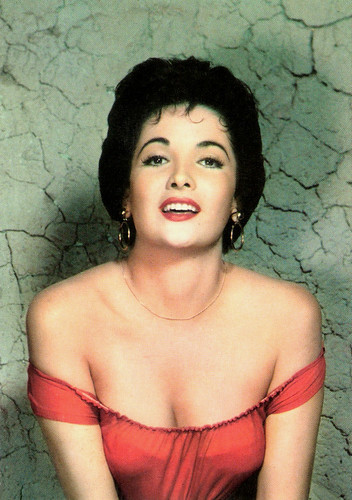
Italian postcard by Rotalcolor, Milano, no. 115.
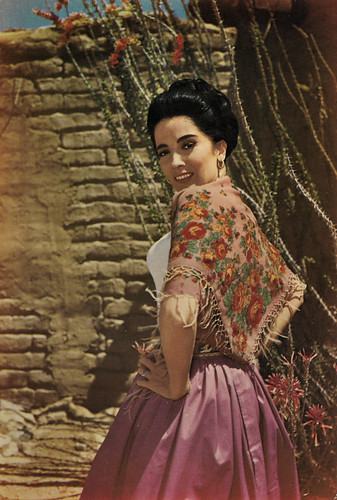
Dutch postcard. Linda Cristal as Victoria Cannon in the American TV series The High Chaparral (1967–1971).
New Star of the Year
Linda Cristal was born as Marta Victoria Moya Peggo in Buenos Aires, Argentina, in 1934. She was the daughter of a French father and an Italian mother. Her father was a publisher who moved the family to Montevideo, Uruguay, because of political problems.
In 1947, Linda and her parents were involved in a road accident near Buenos Aires in Argentina. She survived, but her parents were killed. Linda was 13 at the time. She had two brothers, but of them had died prematurely.
Her education came at Conservatoria Franklin in Uruguay. She learned to speak different languages, such as French, Spanish, Italian, and English.
In 1952, she was discovered by Mexican producer-director Miguelito Aleman, son of the Mexican president, Miguel Aleman. He gave her a bit part in the Mexican crime drama Cuando levanta la niebla/When the Fog Lifts (Emilio Fernández, 1952) starring Arturo de Córdova.
After she started her acting career. she altered her birth name to Linda Cristal. This was a common practice for actors and actresses in that period. In the following four years, Cristal did nine films in Argentina and Mexico for Aleman.
Her first English-language role was as Margarita in the Western Comanche (George Sherman, 1956) with Dana Andrews.
She won a Golden Globe Award for New Star of the Year for her part as Sandra Roca - the Argentine Bombshell in the romantic comedy The Perfect Furlough (Blake Edwards, 1958) with Tony Curtis and Janet Leigh.
Next, Cristal went on to roles in Cry Tough (Paul Stanley, 1959) with John Saxon , the Italian epic Le legioni di Cleopatra/Legions of the Nile (Vittorio Cottafavi, 1959), with Ettore Manni and Georges Marchal , and another Peplum La donna dei faraoni/The Pharaohs' Woman (Victor Tourjansky, 1960) opposite Pierre Brice .
John Wayne asked her to play the part of Flaca in his epic The Alamo (John Wayne, 1960), and then she had a key role in the Western Two Rode Together (John Ford, 1961) starring James Stewart and Richard Widmark.

Italian postcard, no. 640.
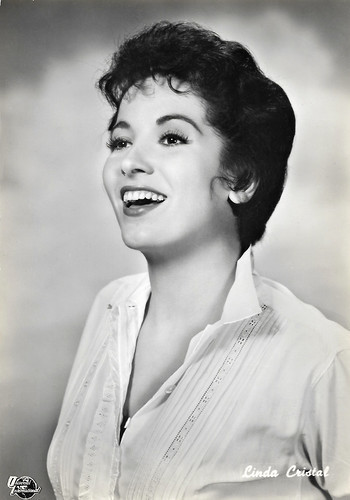
Italian postcard by Bromofoto, no. 1483. Photo: Universal International.
A female matador
Along with these and other film roles, Linda Cristal appeared in episodes of network television series. She played a kidnapped Countess opposite Eric Fleming and Clint Eastwood in an episode of Rawhide (1959).
On television, Cristal also played the female matador Gitana in an episode of The Tab Hunter Show (1961), and appeared in an episode of Voyage to the Bottom of the Sea (1964) with Richard Basehart and Dan Hedison.
Cristal semi-retired in 1964 to raise her two children. She was coaxed out of retirement when she became the last cast member to be added as a regular on the NBC series The High Chaparral (1967-1971), starring Leif Erickson and Cameron Mitchell. Her performance in the series, as Victoria Cannon, earned her two more Golden Globe nominations (winning Best Actress - Television Drama in 1968) and two Emmy Award nominations.
Cristal worked sparingly after The High Chaparral, with a few television and film roles, such as the film Mr. Majestyk (Richard Fleischer, 1974) starring Charles Bronson , and the television miniseries Condominium (Sidney Hayers, 1980) with Barbara Eden.
In 185 she returned to Argentina, where she appeared in the starring role of Victoria "Rossé" Wilson on the soap opera Rossé (Mario Bellocchio, 1985). Her last role was a guest part in an episode of the long-running American daytime drama General Hospital (1988).
Linda Cristal was married thrice. Cristal wed for the first time in 1950 to Tito Gomez, when she was just 16-years-old. The marriage was annulled after five days in the same year. In 1958, she married business man Robert Champion, half-brother of dancer-actor Gower Champion. The secret wedding was made public only after a month. The marriage soon got bitter when Robert got a job in Venezuela, and the couple had to live far from each other for most of the time. They divorced in 1959.
In 1960, she wed Yale Wexler, a former actor who worked in real estate and was a multi-millionaire. The couple divorced in 1966. With Wexler, she has two sons, Gregory S. (1962) and Jordan R. (1963). Linda was granted the custody of both her sons. Away from acting, she became a successful realtor and started an import/export business of her own. Nowadays, she reportedly relishes her retirement life in California with her children.
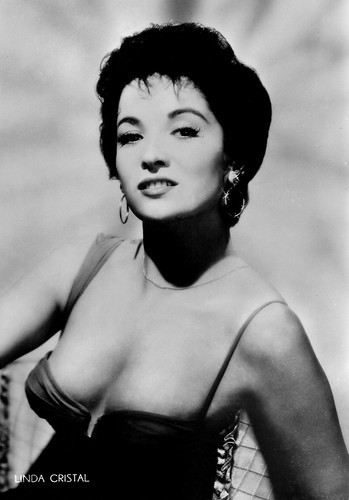
Italian postcard, no. 604. Photo: Universal, 1957.

Spanish postcard by Archivo Bermejo, no. C-35. Photo: Universal International.
Sources: Alchetron, Glamour Girls of the Silver Screen, Wikipedia and .

Italian postcard by Rotalcolor, Milano, no. 115.

Dutch postcard. Linda Cristal as Victoria Cannon in the American TV series The High Chaparral (1967–1971).
New Star of the Year
Linda Cristal was born as Marta Victoria Moya Peggo in Buenos Aires, Argentina, in 1934. She was the daughter of a French father and an Italian mother. Her father was a publisher who moved the family to Montevideo, Uruguay, because of political problems.
In 1947, Linda and her parents were involved in a road accident near Buenos Aires in Argentina. She survived, but her parents were killed. Linda was 13 at the time. She had two brothers, but of them had died prematurely.
Her education came at Conservatoria Franklin in Uruguay. She learned to speak different languages, such as French, Spanish, Italian, and English.
In 1952, she was discovered by Mexican producer-director Miguelito Aleman, son of the Mexican president, Miguel Aleman. He gave her a bit part in the Mexican crime drama Cuando levanta la niebla/When the Fog Lifts (Emilio Fernández, 1952) starring Arturo de Córdova.
After she started her acting career. she altered her birth name to Linda Cristal. This was a common practice for actors and actresses in that period. In the following four years, Cristal did nine films in Argentina and Mexico for Aleman.
Her first English-language role was as Margarita in the Western Comanche (George Sherman, 1956) with Dana Andrews.
She won a Golden Globe Award for New Star of the Year for her part as Sandra Roca - the Argentine Bombshell in the romantic comedy The Perfect Furlough (Blake Edwards, 1958) with Tony Curtis and Janet Leigh.
Next, Cristal went on to roles in Cry Tough (Paul Stanley, 1959) with John Saxon , the Italian epic Le legioni di Cleopatra/Legions of the Nile (Vittorio Cottafavi, 1959), with Ettore Manni and Georges Marchal , and another Peplum La donna dei faraoni/The Pharaohs' Woman (Victor Tourjansky, 1960) opposite Pierre Brice .
John Wayne asked her to play the part of Flaca in his epic The Alamo (John Wayne, 1960), and then she had a key role in the Western Two Rode Together (John Ford, 1961) starring James Stewart and Richard Widmark.

Italian postcard, no. 640.

Italian postcard by Bromofoto, no. 1483. Photo: Universal International.
A female matador
Along with these and other film roles, Linda Cristal appeared in episodes of network television series. She played a kidnapped Countess opposite Eric Fleming and Clint Eastwood in an episode of Rawhide (1959).
On television, Cristal also played the female matador Gitana in an episode of The Tab Hunter Show (1961), and appeared in an episode of Voyage to the Bottom of the Sea (1964) with Richard Basehart and Dan Hedison.
Cristal semi-retired in 1964 to raise her two children. She was coaxed out of retirement when she became the last cast member to be added as a regular on the NBC series The High Chaparral (1967-1971), starring Leif Erickson and Cameron Mitchell. Her performance in the series, as Victoria Cannon, earned her two more Golden Globe nominations (winning Best Actress - Television Drama in 1968) and two Emmy Award nominations.
Cristal worked sparingly after The High Chaparral, with a few television and film roles, such as the film Mr. Majestyk (Richard Fleischer, 1974) starring Charles Bronson , and the television miniseries Condominium (Sidney Hayers, 1980) with Barbara Eden.
In 185 she returned to Argentina, where she appeared in the starring role of Victoria "Rossé" Wilson on the soap opera Rossé (Mario Bellocchio, 1985). Her last role was a guest part in an episode of the long-running American daytime drama General Hospital (1988).
Linda Cristal was married thrice. Cristal wed for the first time in 1950 to Tito Gomez, when she was just 16-years-old. The marriage was annulled after five days in the same year. In 1958, she married business man Robert Champion, half-brother of dancer-actor Gower Champion. The secret wedding was made public only after a month. The marriage soon got bitter when Robert got a job in Venezuela, and the couple had to live far from each other for most of the time. They divorced in 1959.
In 1960, she wed Yale Wexler, a former actor who worked in real estate and was a multi-millionaire. The couple divorced in 1966. With Wexler, she has two sons, Gregory S. (1962) and Jordan R. (1963). Linda was granted the custody of both her sons. Away from acting, she became a successful realtor and started an import/export business of her own. Nowadays, she reportedly relishes her retirement life in California with her children.

Italian postcard, no. 604. Photo: Universal, 1957.

Spanish postcard by Archivo Bermejo, no. C-35. Photo: Universal International.
Sources: Alchetron, Glamour Girls of the Silver Screen, Wikipedia and .
Published on January 19, 2020 22:00
January 18, 2020
Alain Cuny
French actor Alain Cuny (1908-1994) worked in both France and Italy. Among his most notable films are Les Visiteurs du soir (1942), Les Amants/The Lovers (1958), La dolce vita (1960) and Satyricon (1969).
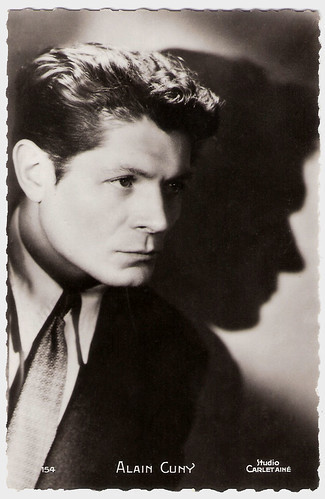
French postcard by Editions P.I., Paris, no. 154. Photo: Carlet Ainé.
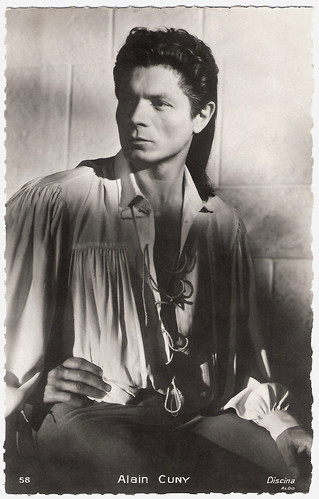
French postcard by E.C., Paris, no. 58. Photo: Aldò Graziati / Discina. Publicity still for Les visiteurs du soir (Marcel Carné, 1942).
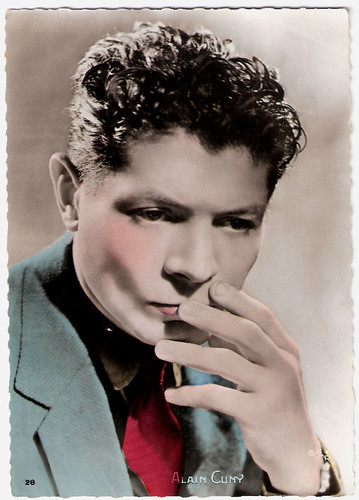
French postcard by Editions P.I., Paris, no. 28. Photo: Star.
Devil's Assistant
Alain Cuny was born René Xavier Marie in Saint-Malo, Brittany, in 1908. There, he attended Insitut Libre de Saint-Lô and the Collège Locroy-Saint-León. Then he studied architecture at École Nationale Supérieure des Beaux-Arts in Paris, and studied drama with Charles Dullin .
He entered the film industry as a costume and set designer for such famous directors as Alberto Cavalcanti, Jacques Feyder, and Jean Renoir. With Cavalcanti he also worked as an assistant director.
At the end of the 1930s Cuny started acting on stage. He made his film debut in an insignificant role in Remorques/Stormy Waters (Jean Grémillon, 1941) starring Jean Gabin .
The following year he became instantly famous with his lively performance as the strolling minstrel and Devil's assistant, Gilles, in Les Visiteurs du soir/The Devil's Envoys (Marcel Carné, 1942) opposite Arletty .
Another popular role was Hervé in the atmospheric tale of the supernatural Le Baron fantôme/The Phantom Baron (Serge de Poligny, 1943). Cuny also collaborated on the script. Opposite Jean Cocteau, as the Baron, Cuny, the Baron's son and heir, created an unusual version of the romantic hero, reflecting the film's fantastic and legendary quality.
During the war he was also active in the theatre. Karl Tabery at Film Reference : “Cuny played increasingly realistic roles, and his performances became deeper and more psychologically complex. This gradual change was probably due to the influence of his theatrical work, especially after he began to appear at the Théâtre National Populaire under Jean Vilar. Cuny's first major stage success came at the 1947 Avignon Festival in Paul Claudel's 'L'Histoire de Tobie et de Sarah', and he also appeared in Vilar's subsequent production of 'Macbeth'.”
In the early 1950s, Cuny began starring in Italian films in addition to French films. Among his Italian films are Il Cristo proibito/Forbidden Christ (Curzio Malaparte, 1951) starring Raf Vallone , and La signora senza camelie/The Lady without Camelias (Michelangelo Antonioni, 1953) featuring Lucia Bosé .
Among his other notable roles of that decade are the villainous cleric Claude Frollo in Notre Dame de Paris/The Hunchback of Notre Dame (Jean Delannoy, 1956) co-starring Gina Lollobrigida and Anthony Quinn , and the husband of Jeanne Moreau in the Nouvelle Vague classic Les Amants/The Lovers (Louis Malle, 1958).
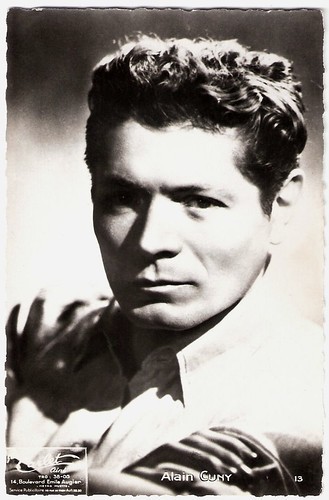
French postcard by Editions E.C., Paris, no. 13. Photo: Carlet Ainé.

French postcard by S.E.R.P., Paris, no. 252. Photo: Studio Harcourt.
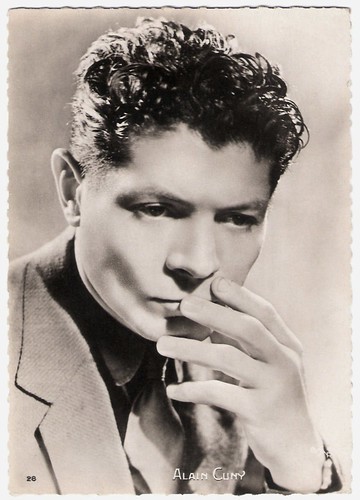
French postcard by Editions P.I., Paris, no. 28. Photo: Star.
Seemingly Quiet and Even-tempered
Alain Cuny got international recognition for his next role as the conflicted philosophising author Steiner in La dolce vita (Federico Fellini, 1960) starring Marcello Mastroianni . Cuny presented Steiner as a seemingly quiet and even-tempered man, living happily with a beautiful and intelligent wife, who yields to a sudden, mysterious attack of folly and commits suicide. A huge worldwide success, La Dolce Vita won several awards, including a New York Film Critics Circle award for Best Foreign Film and the Palme d'Or at the Cannes Film Festival.
Cuny later also appeared in Fellini’s Satyricon (Federico Fellini, 1969), a free adaptation of Petronius' famous farcical chronicle of ancient Roman life starring Martin Potter and Hiram Keller.
He also worked with such noted directors as Mauro Bolognini at La corruzione/Corruption (1963), Marcel Ophüls at the comedy Peau de banane/Banana Peel (1963) and Luis Buñuel at La Voie Lactée/The Milky Way (1969).
Later in his career Cuny had a role in Emmanuelle (Just Jaeckin, 1974). This was the first and original Emmanuelle film in a highly successful series of soft core erotic films starring Sylvia Kristel . The world wide gross of the film was an estimated 100 million dollars.
Also in 1974 he played Sitting Bull in the absurdist Western Touche pas la femme blanche/Don't Touch the White Woman (Marco Ferreri, 1974) starring Catherine Deneuve .
He often worked with director Francesco Rosi such as on the political thriller Cadaveri eccellenti/Illustrious Corpses (1976) with Lino Ventura , and the historical war drama Cristo si è fermato a Eboli/Christ Stopped at Eboli (1979) with Gian Maria Volonté.
Cuny played an old Mafioso in Godard’s Détective/Detective (Jean-Luc Godard, 1987). One of his last roles was in the biography Camille Claudel (Bruno Nuytten, 1988) as Louis-Prosper Claudel, father of the film's tragic heroine ( Isabelle Adjani ).
In 1991 he directed his first film, the romantic drama L'annonce faite à Marie/The Annunciation of Marie (1991).
Alain Cuny died in 1994 in Paris. He was 85. During his life, he befriended women such as Hafida Elalama, and many other models and actresses. Since 1962, he had been married to Marie-Blanche Guidicelli.
Original French trailer for Les Visiteurs du soir/The Devil's Envoys (1942). Source: Joel Spiggott (YouTube).
Original Italian trailer for La dolce vita (1960). Source: Pulp59 (YouTube).
US trailer for Emmanuelle (1974). Source: Robatsea2009 (YouTube).
Sources: Karel Tabery (Filmreference.com), Hal Erickson (AllMovie), Wikipedia, and .

French postcard by Editions P.I., Paris, no. 154. Photo: Carlet Ainé.

French postcard by E.C., Paris, no. 58. Photo: Aldò Graziati / Discina. Publicity still for Les visiteurs du soir (Marcel Carné, 1942).

French postcard by Editions P.I., Paris, no. 28. Photo: Star.
Devil's Assistant
Alain Cuny was born René Xavier Marie in Saint-Malo, Brittany, in 1908. There, he attended Insitut Libre de Saint-Lô and the Collège Locroy-Saint-León. Then he studied architecture at École Nationale Supérieure des Beaux-Arts in Paris, and studied drama with Charles Dullin .
He entered the film industry as a costume and set designer for such famous directors as Alberto Cavalcanti, Jacques Feyder, and Jean Renoir. With Cavalcanti he also worked as an assistant director.
At the end of the 1930s Cuny started acting on stage. He made his film debut in an insignificant role in Remorques/Stormy Waters (Jean Grémillon, 1941) starring Jean Gabin .
The following year he became instantly famous with his lively performance as the strolling minstrel and Devil's assistant, Gilles, in Les Visiteurs du soir/The Devil's Envoys (Marcel Carné, 1942) opposite Arletty .
Another popular role was Hervé in the atmospheric tale of the supernatural Le Baron fantôme/The Phantom Baron (Serge de Poligny, 1943). Cuny also collaborated on the script. Opposite Jean Cocteau, as the Baron, Cuny, the Baron's son and heir, created an unusual version of the romantic hero, reflecting the film's fantastic and legendary quality.
During the war he was also active in the theatre. Karl Tabery at Film Reference : “Cuny played increasingly realistic roles, and his performances became deeper and more psychologically complex. This gradual change was probably due to the influence of his theatrical work, especially after he began to appear at the Théâtre National Populaire under Jean Vilar. Cuny's first major stage success came at the 1947 Avignon Festival in Paul Claudel's 'L'Histoire de Tobie et de Sarah', and he also appeared in Vilar's subsequent production of 'Macbeth'.”
In the early 1950s, Cuny began starring in Italian films in addition to French films. Among his Italian films are Il Cristo proibito/Forbidden Christ (Curzio Malaparte, 1951) starring Raf Vallone , and La signora senza camelie/The Lady without Camelias (Michelangelo Antonioni, 1953) featuring Lucia Bosé .
Among his other notable roles of that decade are the villainous cleric Claude Frollo in Notre Dame de Paris/The Hunchback of Notre Dame (Jean Delannoy, 1956) co-starring Gina Lollobrigida and Anthony Quinn , and the husband of Jeanne Moreau in the Nouvelle Vague classic Les Amants/The Lovers (Louis Malle, 1958).

French postcard by Editions E.C., Paris, no. 13. Photo: Carlet Ainé.

French postcard by S.E.R.P., Paris, no. 252. Photo: Studio Harcourt.

French postcard by Editions P.I., Paris, no. 28. Photo: Star.
Seemingly Quiet and Even-tempered
Alain Cuny got international recognition for his next role as the conflicted philosophising author Steiner in La dolce vita (Federico Fellini, 1960) starring Marcello Mastroianni . Cuny presented Steiner as a seemingly quiet and even-tempered man, living happily with a beautiful and intelligent wife, who yields to a sudden, mysterious attack of folly and commits suicide. A huge worldwide success, La Dolce Vita won several awards, including a New York Film Critics Circle award for Best Foreign Film and the Palme d'Or at the Cannes Film Festival.
Cuny later also appeared in Fellini’s Satyricon (Federico Fellini, 1969), a free adaptation of Petronius' famous farcical chronicle of ancient Roman life starring Martin Potter and Hiram Keller.
He also worked with such noted directors as Mauro Bolognini at La corruzione/Corruption (1963), Marcel Ophüls at the comedy Peau de banane/Banana Peel (1963) and Luis Buñuel at La Voie Lactée/The Milky Way (1969).
Later in his career Cuny had a role in Emmanuelle (Just Jaeckin, 1974). This was the first and original Emmanuelle film in a highly successful series of soft core erotic films starring Sylvia Kristel . The world wide gross of the film was an estimated 100 million dollars.
Also in 1974 he played Sitting Bull in the absurdist Western Touche pas la femme blanche/Don't Touch the White Woman (Marco Ferreri, 1974) starring Catherine Deneuve .
He often worked with director Francesco Rosi such as on the political thriller Cadaveri eccellenti/Illustrious Corpses (1976) with Lino Ventura , and the historical war drama Cristo si è fermato a Eboli/Christ Stopped at Eboli (1979) with Gian Maria Volonté.
Cuny played an old Mafioso in Godard’s Détective/Detective (Jean-Luc Godard, 1987). One of his last roles was in the biography Camille Claudel (Bruno Nuytten, 1988) as Louis-Prosper Claudel, father of the film's tragic heroine ( Isabelle Adjani ).
In 1991 he directed his first film, the romantic drama L'annonce faite à Marie/The Annunciation of Marie (1991).
Alain Cuny died in 1994 in Paris. He was 85. During his life, he befriended women such as Hafida Elalama, and many other models and actresses. Since 1962, he had been married to Marie-Blanche Guidicelli.
Original French trailer for Les Visiteurs du soir/The Devil's Envoys (1942). Source: Joel Spiggott (YouTube).
Original Italian trailer for La dolce vita (1960). Source: Pulp59 (YouTube).
US trailer for Emmanuelle (1974). Source: Robatsea2009 (YouTube).
Sources: Karel Tabery (Filmreference.com), Hal Erickson (AllMovie), Wikipedia, and .
Published on January 18, 2020 22:00
Paul van Yperen's Blog
- Paul van Yperen's profile
- 13 followers
Paul van Yperen isn't a Goodreads Author
(yet),
but they
do have a blog,
so here are some recent posts imported from
their feed.



